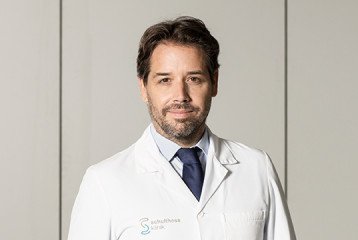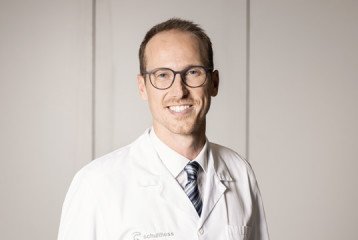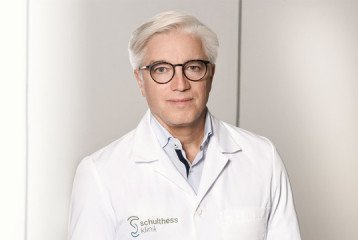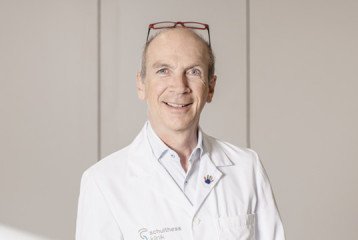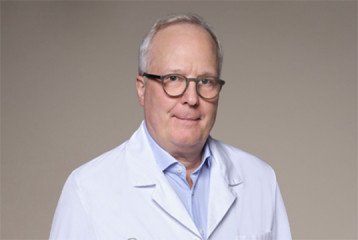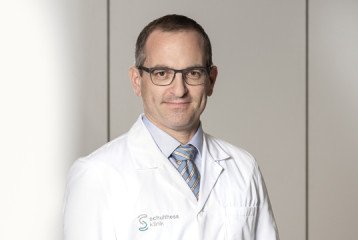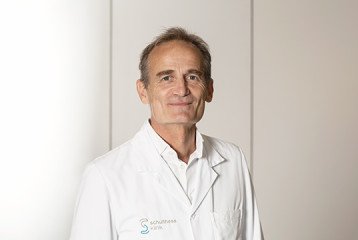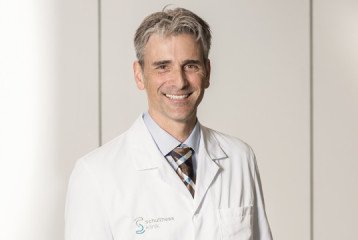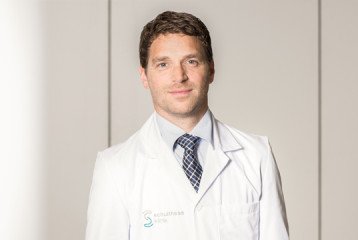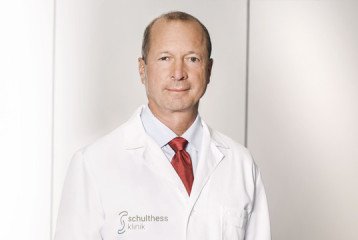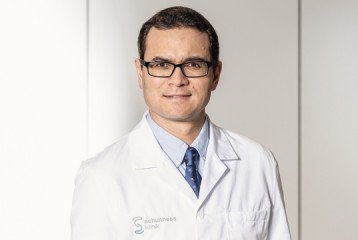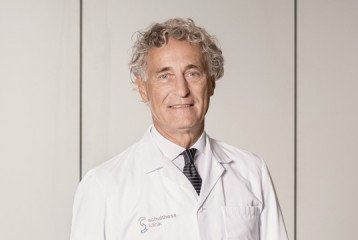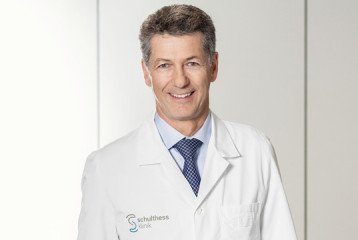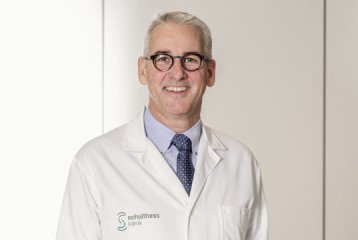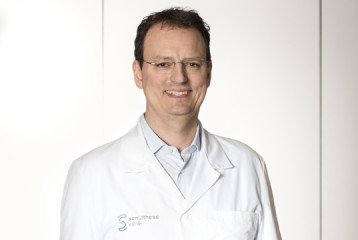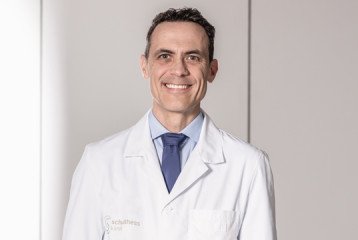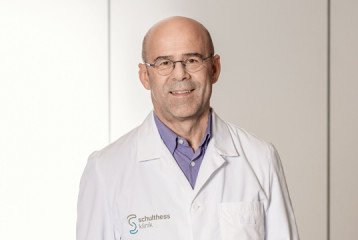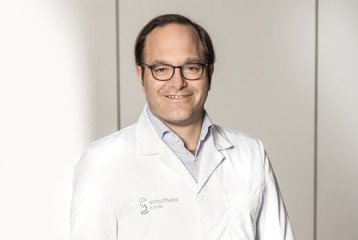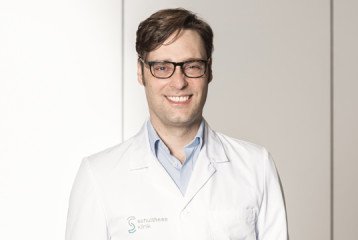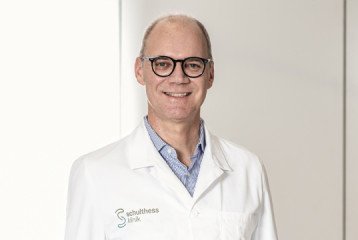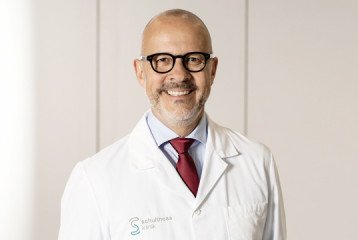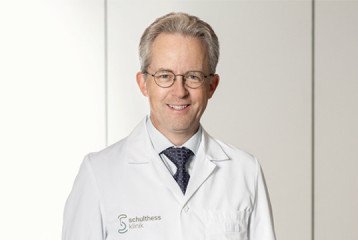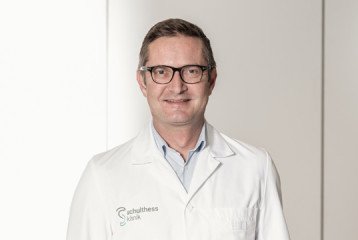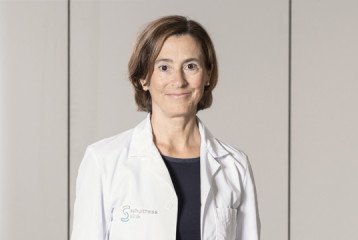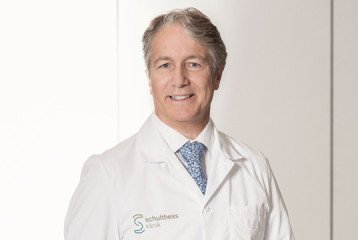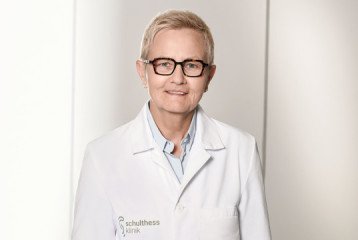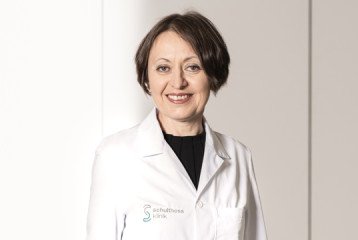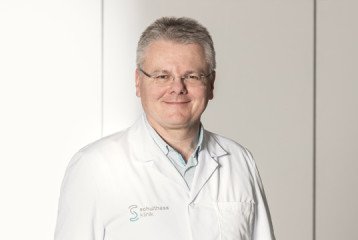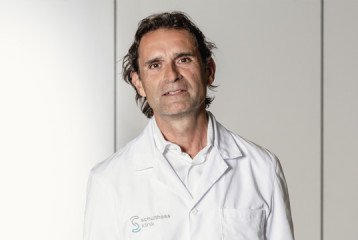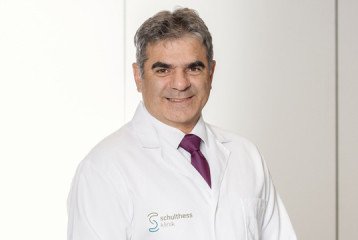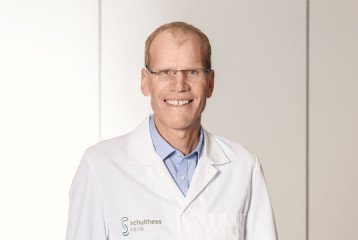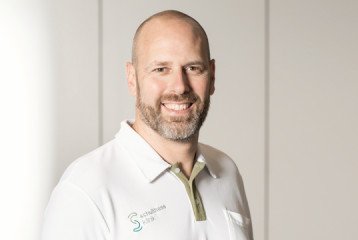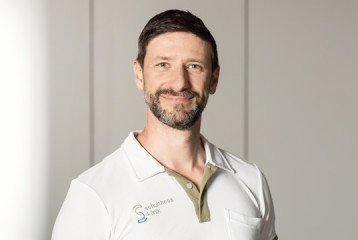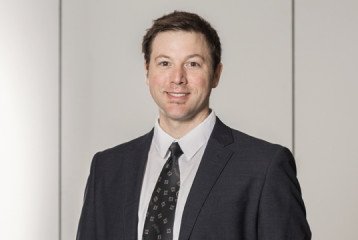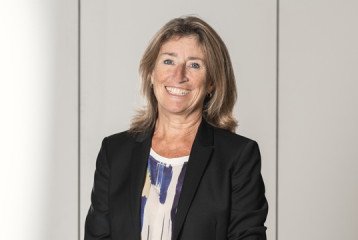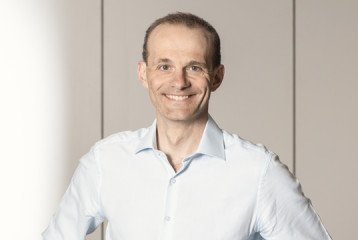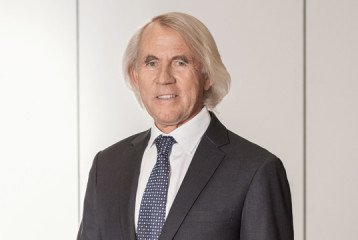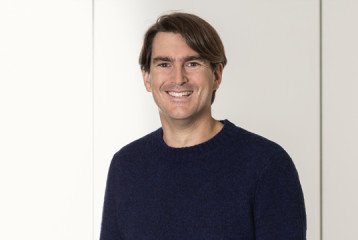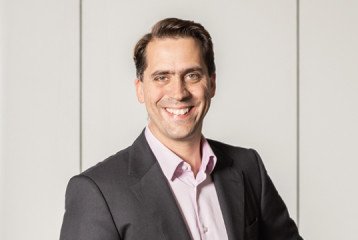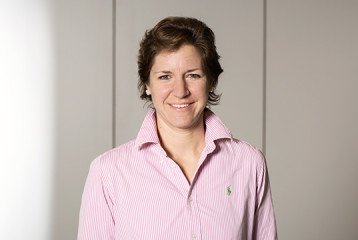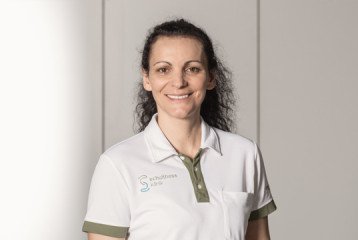Annual Report 2021
HEALING, RESEARCHING, HELPING has been our motto since 1883 in our journey to share the joy of movement. Read our annual report to find out what our 1,131 employees did to achieve this in 2021 with CUTTING-EDGE MEDICINE, INNOVATION and HUMANITY.
“HEALING in the sense of cutting-edge medicine means taking a holistic view of the patient and thus offering them the best treatment on a scientific basis.”
Franz K. von Meyenburg, President, Board of Trustees
“RESEARCH means questioning our daily routine and continuously improving quality through innovative solutions.”
Prof. Dr. Michael Leunig, Chief Medical Officer, CMO
“HELPING means empowering and supporting our employees. Only in this way can they, in turn, help our patients on their road to recovery.”
Andrea Rytz, Director, CEO
Once again, we look back on an intense year that has demanded a great deal from all of us, especially due to the pandemic: We have had to show flexibility, patience and perseverance at every turn, which makes us all the more proud that we can look back on a successful 2021. We would like to thank all patients and referring doctors for the trust they have placed in us and our employees for their huge commitment.
The Wilhelm Schulthess Foundation
For years, Schulthess Klinik has been regarded by specialists and patients as one of the world's best destinations for orthopaedics. A lesser known, but equally important fact is that our clinic is a not-for-profit business. We have been a foundation for almost 90 years, since 1935. Our driving principles are cutting-edge medicine for all, scientific innovation and warm humanity, in the spirit of our founder Wilhelm Schulthess.
Healing – cutting-edge medicine
To free people from their pain and help them find new joy in movement: that has always been our ultimate goal. We do this with a high degree of specialisation and the wealth of expertise and experience that our specialists bring. As an orthopaedic clinic, we focus entirely on the musculoskeletal system. This specialisation is also reflected in the individual departments. They in turn work together on an interdisciplinary basis – in both conservative treatment and surgery. This means that the patient benefits not just from having a highly specialised treating doctor, but also from the big picture.
Research – innovation
Cutting-edge medicine is only possible if you know what you are doing. A sound scientific basis is at the top of our priorities. That is why research has a long tradition here at Schulthess Klinik. Prof. Norbert Gschwend laid the foundation for outcome research back in 1972 by introducing internal registries for hip and knee prostheses. Since then, our research has continued to evolve. The focus is always on the patient. That is why we monitor our patients closely even after treatment. For example, we have conducted over 186,000 systematic patient surveys since 2004. From this data, we draw important conclusions for the future with studies that directly inform clinical practice for the benefit of patients. With publications, teaching activities and cooperative ventures, we spread our knowledge to colleagues at home and abroad, so that treatments can be constantly improved.
Donations to the Wilhelm Schulthess Foundation Research Fund thus directly support scientific training, research and development in the field of orthopaedics and benefit not only our patients, but patients all over the world.
Innovation also means being open to new things at all times and constantly questioning the day-to-day routine. This has also led to various improvements and innovative solutions in 2021, both large and small, medical and non-medical: robotics in the operating room and in logistics, innovative aids for patient care, various changes to become even more sustainable in the sense of “Schulthess Klinik goes green”, and flexible employment models are just a few examples.
Help – humanity
The charitable principle of the Wilhelm Schulthess Foundation remains an important cornerstone of our work and part of our DNA. The focus here is on our Fund, which supports patients from Germany and abroad who are facing complex orthopaedic treatment and cannot afford it. In particular, we also help children from war zones who need surgery (see below in the sub-report on Paediatric Orthopaedics). Donations to our Patient Assistance Fund thus go directly to alleviating the plight of people in need.
“Helping” is also a continuous cycle. A cycle of giving, taking and passing on. We are only able to monitor our patients so well on their road to recovery because we can count on the tireless efforts of our personnel from all departments day in, day out. This in turn means that we are at all times committed to providing our employees with a healthy foundation for them to flourish with our support and encouragement. Aspects of this include a pleasant working environment, family-friendly working conditions, healthy and sustainable cuisine, opportunities for further development and much more.
We really appreciate the team spirit, commitment, flexibility and imagination shown by our 1,131 employees and would like to thank them for their exceptional performance in 2021. Without them, we would not be do everything we do and provide our patients with the help they need.
Shoulder and Elbow Surgery

Our specialists in the Shoulder and Elbow Surgery department treat all types of shoulder and elbow conditions and injuries. The department treats complaints ranging from fractures and ligament and tendon injuries to conditions caused by wear such as osteoarthritis. We offer both conservative and surgical treatment, including joint replacement and complex revision surgery. This involves our specialists working closely with our research department, which means scientific research can be incorporated directly into everyday clinical practice and, in turn, practical experience can influence research results. We also share our knowledge with colleagues in Switzerland and abroad through our publications, in-clinic teaching activities and conferences. Fittingly, the year 2021 was characterised by teaching and research.
“RESEARCH – and the advancement of innovations that comes with it – is the driving force of progress in medicine. It helps us to implement cutting-edge medicine for the benefit of our patients who are suffering from shoulder and elbow problems as well as to improve results in the long term.”
Prof. Dr. Markus Scheibel, Head of Shoulder and Elbow Surgery
Recognition as a teaching centre by SECEC/ESSSE
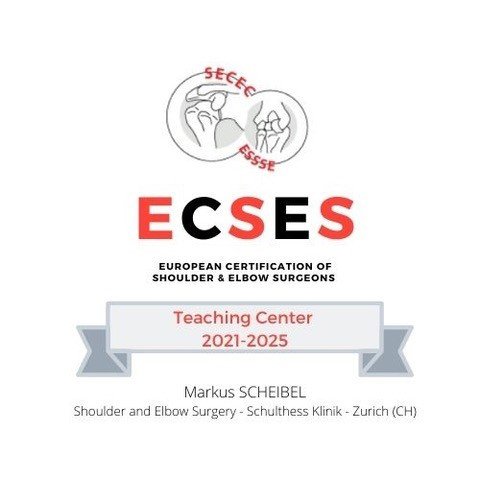
In September 2021, the European Society for Surgery of the Shoulder and the Elbow (SECEC/ESSSE) recognised our Shoulder and Elbow Surgery department, which is led by Prof. Dr. med. Markus Scheibel, as a teaching centre. SECEC/ESSSE introduced this certificate to ensure uniformly high standards of quality in the training of young shoulder and elbow surgeons and, correspondingly, high standards in the practice of shoulder and elbow surgery across Europe. In order to receive this certification, an institution needs to have attended a significant number of training courses and conferences recognised by SECEC/ESSSE and have fellowships at SECEC/ESSSE-recognised teaching centres.
Schulthess Klinik is delighted to have been named as a teaching centre and looks forward to making an even greater contribution to training shoulder and elbow surgeons at the European level.
Virtual Shoulder and Elbow Symposium
Likewise, we shared our knowledge at our first virtual Shoulder and Elbow Symposium. The pandemic forced us to take the symposium online, where we were able to reach over 500 participants. The event focused on current therapy concepts, new trends in diagnostics and in the treatment of injuries and degenerative/inflammatory pathologies of the shoulder and elbow. Anyone interested in the subject can access the symposium lectures online.
Traumatology with accident helpline
The shoulder and elbow are susceptible to a wide variety of injuries including fractures and injured tendons. At Schulthess Klinik, we treat all monotraumas of the shoulder and elbow, including complex fractures and revisions of improperly healed traumas.
Every trauma beings with an accident and how the patient deals with the injury immediately afterwards. The patient has to ask themselves questions like “What immediate action needs to be taken?” or “Do I need my GP or even a specialist?”. This is specifically why Schulthess Klinik set up an accident helpline in 2020 and expanded and publicised it further in 2021. This allows patients to seek medical advice 12 hours a day on what to do after they have had an accident. “In the event of an accident, the immediate treatment sought is often a decisive factor in a successful healing process and can help avoid lengthy follow-up treatments,” Dr. med. Fabrizio Moro, Co-Head of Shoulder and Elbow Surgery explains. “This is why we recommend seeking the advice of a specialist just to be sure. Our accident helpline is ideal for this. Over the past year, we’ve been able to guide numerous patients towards the right treatment path for them.”
Stromeyer-Probst Medal for textbook “The Shoulder – Expertise in Orthopaedics and Trauma Surgery” (original title “Schulter – Expertise Orthopädie und Unfallchirurgie”).
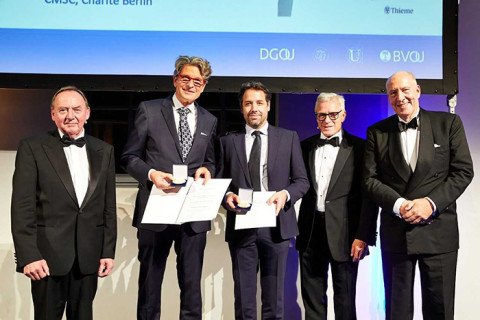
Prof. Dr. Markus Scheibel was awarded the Stromeyer-Probst Medal by the German Society for Trauma Surgery (DGU). The award was presented in recognition of the textbook “The Shoulder – Expertise in Orthopaedics and Trauma Surgery”, which Prof. Dr. Scheibel co-published with Prof. Dr. Dr. Ulrich H. Brunner of Orthoclinic Agatharied, and numerous other authors. This collaborative work reflects the authors’ vast clinical experience, describes standards and aims to ensure safety in patient care. It is aimed both at shoulder surgeons undergoing further training and at trained orthopaedic surgeons looking to specialise in shoulder surgery.
The DGU awards this medal once a year for outstanding scientific works in the field of trauma surgery and general traumatology literature.
Election of our specialists to offices of international professional societies
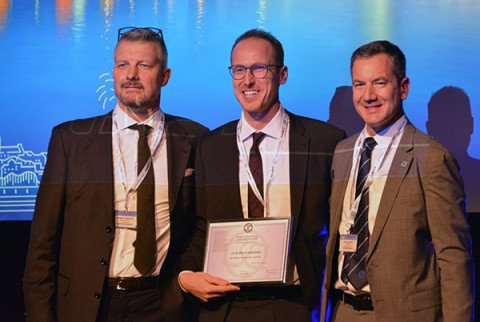
Two of our specialists were elected to leading positions in international professional societies last year: Prof. Dr. med. univ. Philipp Moroder is a new board member of the European Society for Surgery of the Shoulder and the Elbow (SECEC/ESSSE). For the period from 2021 to 2024, Prof. Dr. med. Markus Scheibel is General Secretary of the German Society of Shoulder and Elbow Surgery (DVSE), where he was President from 2015 to 2021, and President of the German Society for Orthopaedics and Orthopaedic Surgery (DGOOC) (until 2024).
Honorary memberships of our specialists
Due to their commitment to medicine and teaching, two specialists were appointed honorary members of international professional societies: The Polish Association for Shoulder and Elbow Surgery (PTBiŁ) appointed Prof. Dr. med. Markus Scheibel and the Francophone Arthroscopy Society (SFA) Prof. Dr. med. univ. Philipp Moroder as honorary members.
Further information
Hand Surgery
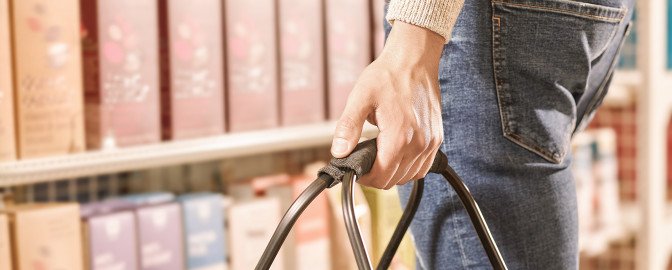
Our hand surgery specialists provide the entire spectrum of surgical and non-surgical treatments for the hand and forearm. The focus is always on the patient and delivering the best possible solution for them based on many years of experience and scientific research.
“For us, RESEARCH means improving and using our own data to increase the efficacy, functionality and cost-effectiveness of our treatment.”
Dr. med. Daniel Herren MHA, Head of Hand Surgery
JHSE Editors’ Award received for the second time in a row
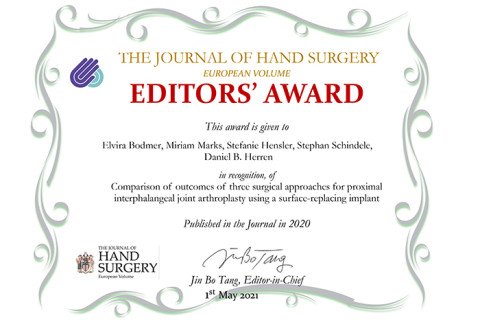
In May 2021, a study of our hand surgery won the JHSE Editors’ Award. This prize, which is conferred by the Journal of Hand Surgery (European Volume), the most renowned international journal in the field of hand surgery, went to our team for the second time in a row. Not even a fifth of the submitted articles make it to publication due to the journal’s strict peer review process. The 2020 Editors’ Award honours the journal’s top eight articles from the previous year.
The award-winning study deals with the use of the CapFlex prosthesis, which is used to treat osteoarthritis of the interphalangeal joint, and was developed at Schulthess Klinik. Our team investigated the influence of the incision, i.e. the surgical access route, on finger function. It concluded that the so-called central tendon-splitting approach leads to fewer complications and tends to improve finger function.
CapFlex finger joint prosthesis: five-year results published
There is another comprehensive study revolving around the CapFlex prosthesis developed at Schulthess Klinik. After over ten years of working with the implant and more than 330 CapFlex prostheses implanted at Schulthess Klinik, our team has now published the initial findings in a renowned international journal, five years after surgery. The results of the study confirm a significant reduction in pain and improvement in hand function compared with before surgery as well as a comparatively low revision rate.
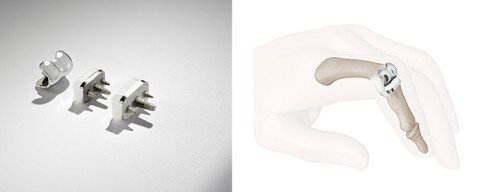
World’s first implant of a KeriFlex finger joint prosthesis
The KeriFlex finger joint prosthesis is used for patients experiencing painful deterioration of their metacarpophalangeal and interphalangeal joints as the result of an accident or illness. Our Head of Hand Surgery, Dr. med. Daniel Herren MHA, developed the new prostheses, as well as the surgical techniques and implements required to perform the operation, in partnership with his friend and colleague Dr Peter Weiss of Brown University in Providence, Rhode Island. The KeriFlex finger joint prosthesis is based on an existing silicone implant. The new models have a better fit and optimised mechanical properties.
The world’s first implantation was performed on 19 January 2021 by our hand surgery specialist, Dr. med. univ. Vanessa Reischenböck.
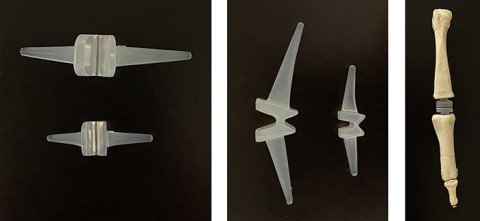
Active participation in congresses and courses at the professional societies
With numerous lectures and presentations, Schulthess Klinik was well represented at the conferences of the European and Swiss professional societies in the field of hand surgery in 2021.
At the FESSH-ON(line)-WEEK, the congress of the European Society for Hand Surgery, which featured the main topic “Dealing with complications”, our hand surgery and science staff shared their current research results with the international audience in 12 congress presentations.
The 2021 Annual Congress of the Swiss Society for Hand Surgery (SGH) and the Swiss Society for Hand Rehabilitation (SGHR) was held under the motto “Passion Hand”. Here, too, our staff contributed to a lively exchange among colleagues in the field with numerous lectures, presentations and posters – all with the aim of being able to offer our patients the latest scientifically based treatment methods.
Isoforce hand splint outrigger launches internationally
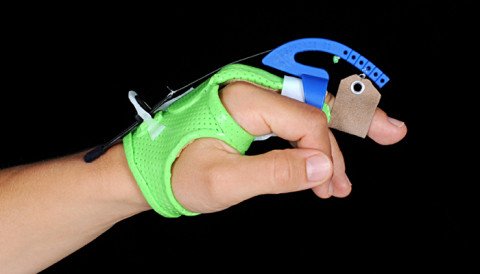
Together with ETH Zurich, Schulthess Klinik developed the Isoforce hand splint outrigger. The device is used in ergotherapy to treat injuries and diseases that permanently restrict movement in the interphalangeal joint.
Our ergotherapy team has been using the splint outrigger in treating their patients for years, and the design has continued to garner a great deal of interest among professionals when presented at training programmes held both in Switzerland and abroad. The Journal of Hand Therapy published the results of a biomechanical study featuring the device. Since 11 June 2021, the company Orfit, which distributes medical products globally, has taken over the production and international distribution of the outrigger, allowing even more patients to benefit from the innovation.
Video consultations
Whether it is because of the pandemic or for geographical or organisational reasons, going to the doctor’s office is not always the preferred choice and in some cases it is not even necessary. This is why we have been offering video consultations since last year. For many patients, this is a welcome and effective substitute for in-person consultations, for example for an initial consultation or when surgery will most likely not be necessary. Patients who qualify for a video consultation are contacted in advance and offered the virtual consultation option. It is often faster to get an online appointment than an in-person one at the clinic.
After the pilot phase, we were able to draw a positive conclusion on the project. Video appointments with patients are working brilliantly. This new option, which became available for patients in 2021 as a result of the pandemic, was very well received and was incorporated into our patient service on a permanent basis in January 2022.
New textbook for hand surgery
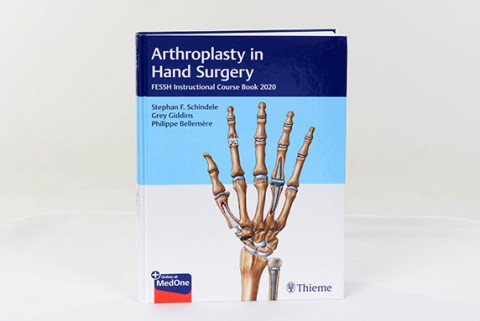
Dr. med. Stephan Schindele, our Co-Head of Hand Surgery, has published a new textbook entitled “Arthroplasty in Hand Surgery”, which he co-authored with the renowned hand surgeons Dr Grey Giddins of the United Kingdom and Dr Philippe Bellemère of France.
Written by international experts, the 35-chapter book contains a comprehensive description of the surgical treatment of hand and finger joints using artificial joints. The textbook is aimed both at young, up-and-coming surgeons and experienced orthopaedists and hand surgeons. Schulthess Klinik’s own Dr. med. Stephan Schindele, Dr. med. Daniel Herren, Dr. med. Michael Brodbeck and Dr. phil. Miriam Marks each contributed a few chapters to the publication.
Further information
Hip Surgery
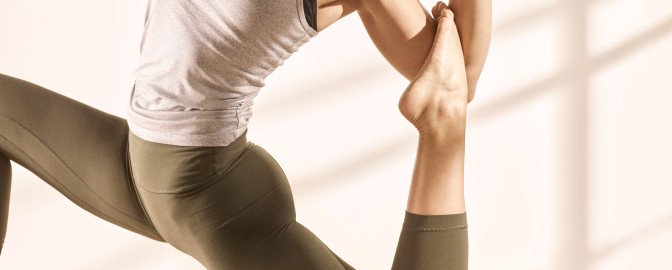
The Hip Surgery department at Schulthess Klinik is Switzerland's largest centre of expertise for hip replacements. We insert about 1,200 hip prostheses annually and also perform complex revision surgeries. In addition to joint replacement, our specialists offer the entire spectrum of hip surgery. This includes the treatment of dislocations and fractures, as well as complex joint-preserving procedures such as arthroscopic surgery, position correction and cartilage repair. All procedures are monitored and documented by our scientific team with regard to short-term and long-term results in order to continuously improve the quality of treatment. The doctors themselves are actively involved in the research.
“HEALING means offering the full spectrum of treatment, i.e. from joint preservation to joint replacement, so that no unnecessary or premature operations are performed. Only proven procedures are used in the process.”
Prof. Dr. med. Michael Leunig
Revision rate: more than twice as good as the Swiss average
Every year, several thousand prostheses are implanted in Switzerland. This now includes over 21,000 hip operations per year, including over 1,200 in 2021 at Schulthess Klinik alone. Ten years on from the launch of the Swiss national implant registry SIRIS, data on the complication rate of an implant can now be tracked and compared nationally and internationally. Hospitals in Switzerland have joined the national quality assurance agreement and have thus made a commitment to data collection. In addition to an annual scientific report, the national data is also published in an abridged version by the National Association for Quality Development in Hospitals and Clinics ANQ.
Long before the introduction of SIRIS, the research department of Schulthess Klinik was already collecting such data in order to be able to conduct its own quality reviews. The national comparison confirms the quality of the internal data.
Since the launch of the SIRIS implant registry in 2012, an increasing number of hip prostheses have been fitted. Schulthess Klinik has been one of the leading orthopaedic clinics in Switzerland for many years. The high number of cases treated by the clinic means that its surgeons are now experienced in the routine performance of this procedure. This also extends to the surgical specialists, nurses, physiotherapists and so on, meaning that patients receive optimal care at every step of the way. Meanwhile, the high level of expertise also leads to short surgery times and initial mobilisation on the same day. The revision rate, which has been very low for years and is on a downward trend, is proof of the outstanding quality of Schulthess Klinik. With the highest number of cases in Switzerland, Schulthess Klink has one of the lowest 2-year revision rates of just 1.2%, less than half the Swiss average of 2.6% (evaluated period from 01/01/2015 to 31/12/2018)
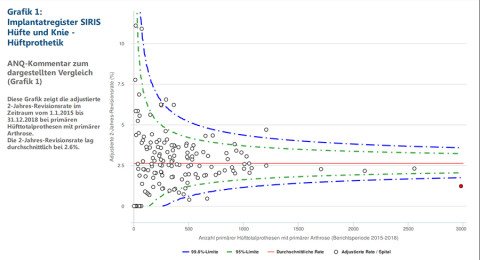
Image source: www.anq.ch
Low infection rate for primary hip prostheses compared to the Swiss average
The Swiss Registry for Postoperative Infections Swissnoso is an important quality tool for hospitals. Since 2009, most Swiss hospital departments have participated. The rate of infection one year after a hip replacement is the most important quality criterion here. This amounts to 0.94% for the current evaluation period from 01/10/2019 to 30/09/2020 at Schulthess Klinik and is thus below the Swiss average (1.19%).
Professorship for Hannes A. Rüdiger
In January, our Co-Head of Hip Surgery, Hannes A. Rüdiger, was appointed titular professor by the University of Zurich. This title serves as recognition of his achievements in both science and teaching over the last few years,
which include the publication of numerous studies in the field of hip prosthetics (artificial joint replacement) in international journals. He is also heavily involved in teaching, as he wants to spread his knowledge and experience to the next generation of doctors. As a result, he can regularly be found teaching clinical courses at the University of Zurich and ETH Zurich. He is also a member of the Swiss orthopaedics continuing education committee and regularly participates as an expert in the orthopaedic specialist examination.
Further information
Knee Surgery
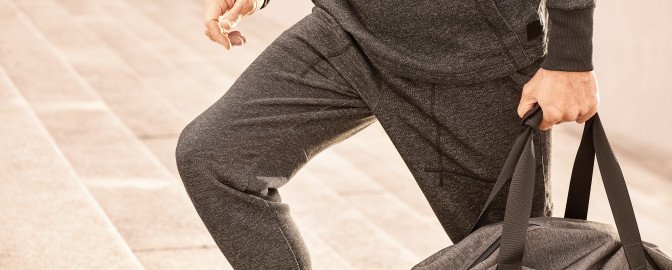
The Knee Surgery department at Schulthess Klinik is Switzerland’s largest reference centre for knee joint replacement. Jährlich setzt die Abteilung rund 850 Knieprothesen ein und führt auch komplexe Revisionseingriffe durch. In addition to prosthetics, our specialists offer the entire treatment spectrum for diseases and injuries of the knee. This ranges from non-surgical treatment techniques to cartilage repair, axial correction, fracture care and complex ligament reconstruction.
“HEALING in the sense of cutting-edge medicine means that we help our patients to regain the joy of movement thanks to our extensive experience and high precision.”
Dr. Stefan Preiss, Head of Knee Surgery
Revision rate: more than twice as good as the Swiss average
Every year, several thousand prostheses are implanted in Switzerland. This now includes nearly 18,000 knee replacement operations per year, 850 of which were performed at Schulthess Klinik in 2021 alone. Ten years on from the launch of the Swiss national implant registry SIRIS, data on the complication rate of an implant can now be tracked and compared nationally and internationally. Hospitals in Switzerland have joined the national quality assurance agreement and have thus made a commitment to data collection. In addition to an annual scientific report, the national data is also published in an abridged version by the National Association for Quality Development in Hospitals and Clinics ANQ.
Long before the introduction of SIRIS, the research department of Schulthess Klinik was already collecting such data in order to be able to conduct its own quality reviews. The national comparison confirms the quality of the internal data.
Since the launch of the SIRIS implant registry in 2012, an increasing number of knee prostheses have been fitted. Schulthess Klinik has been one of the leading orthopaedic clinics in Switzerland for many years. The high number of cases treated by the clinic means that its surgeons are now experienced in the routine performance of this procedure. This also extends to the surgical specialists, nurses, physiotherapists and so on, meaning that patients receive optimal care at every step of the way. Meanwhile, the high level of expertise also leads to short surgery times and initial mobilisation on the same day. The revision rate, which has been very low for years and is on a downward trend, is proof of the outstanding quality of Schulthess Klinik. With almost the highest number of cases in Switzerland, Schulthess Klink has one of the lowest 2-year revision rates of just 1.6%, less than half the Swiss average of 3.5% (evaluation period from 01/01/2015 to 31/12/2018).
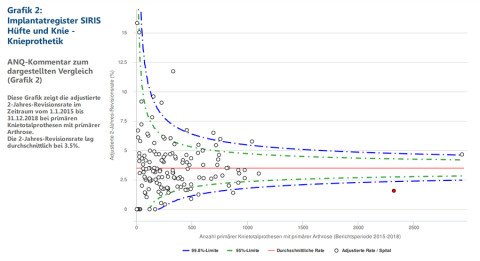
Image source: www.anq.ch
Less than half the infection rate for knee prostheses compared to the Swiss average
The Swiss Registry for Postoperative Infections Swissnoso is an important quality tool for hospitals. Since 2009, the majority of Swiss hospitals have opted to use it. The rate of infection one year after a hip replacement is the most important quality criterion here. This amounts to 0.43% for the current evaluation period from 01/10/2019 to 30/09/2020 at Schulthess Klinik (Swiss average: 0.99%). This means that the risk of infection during the insertion of a knee prosthesis at Schulthess Klinik is less than half the Swiss average.
Surgical robots
Digitalisation is also making its way into operating rooms. As an innovative clinic, we are constantly on the lookout for the latest technologies and trends. For example, our knee team is continuously gaining experience with the latest generation of orthopaedic robots designed to support the use of knee prostheses. In 2021, we specifically evaluated Zimmer Biomet’s “ROSA” orthopaedic robot. Dr. Gregor Baumann, Senior Consultant in Knee Surgery, performed more than 50 surgeries in 2021 with the support of “ROSA.” The robot does not operate alone, but assists the surgeon according to their instructions. Incision assistance is provided, as well as component alignment and ligament balancing to optimise and validate the overall result. However, the final decision for each step lies with the surgeon, who has many years of experience.
The experience from last year is very positive. Non-validated surgeon observations show very good results with no outliers. Whether the clinical benefits to patients outweigh the costs in the long term will become clear once studies are available.
Further information
Foot Surgery
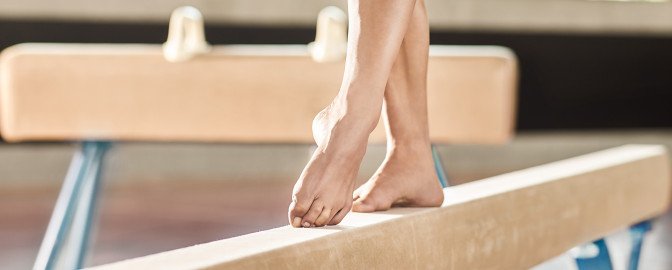
The team of ten specialists in foot surgery treats conditions and injuries of the entire foot and ankle. With almost 1,500 foot operations and over 15,000 outpatient consultations per year, the Foot Surgery department at Schulthess Klinik is one of the largest foot centres in Europe. Since many conditions can also be treated without surgery, close cooperation between doctors who specialise in non-surgical treatment and surgeons in our department is extremely important in order to be able to offer the patient the best treatment for them.
“For us, HEALING in the sense of cutting-edge medicine means experience, quality and offering the latest diagnostic and treatment procedures without losing sight of our focus and the well-being of the patient.”
Dr. med. Pascal Rippstein, Head of Foot Surgery
Once again, we look back on a year full of challenges. Thanks to the outstanding infrastructure of Schulthess Klinik and how well our department is organised, we were in a good position to react with flexibility to the challenges posed by the pandemic and can look back on a successful year both in terms of consultations and surgeries.
Close contact with referring physicians
Unfortunately, we had to cancel our regular GP workshops once again. Despite these difficulties, we managed to organise a range of events, including an interactive virtual lecture as part of the congress of the College of General Practitioners in Lucerne, which received an extremely positive response. So as not to lose the close contact we have to our referring specialists, we are also available for queries or short-term referrals during consultation hours via a helpline.
Interdisciplinary collaboration
As in previous years, we maintained an active interdisciplinary relationship with our colleagues in the other specialist departments of the clinic to ensure we can offer patients the best possible treatment, including in a holistic sense. When it comes to the foot and ankle area in particular, we draw on the expertise of our colleagues from Rheumatology, Sports Medicine and Neurology.
Osteoarthritis of the upper ankle joint
The surgical treatment of osteoarthritis of the upper ankle joint is and remains a controversial topic. Considerable progress has been made in recent years in the field of endoprosthetics with regard to prosthesis design, materials and instruments used. However, with arthrodesis (joint stiffening), we also have an extremely reliable and successful procedure at our disposal.

The indication requires tact, experience and foresight to be able to offer patients the right option. And thanks to our expertise from almost thirty years of work in the field of endoprosthetics, over a thousand implanted ankle prostheses and the co-development of two implant models, this is guaranteed at a very high level in our department.
Further information
Spine Surgery, Orthopaedics and Neurosurgery
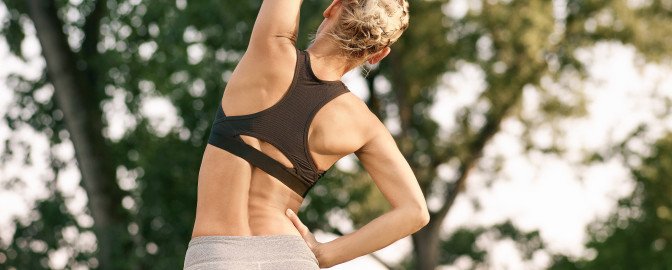
Our Spine Surgery, Orthopaedics and Neurosurgery specialists focus on the treatment of spinal injuries and diseases. These include degenerative disorders, deformities, inflammation, tumours and fractures. The team works in a highly specialist, interdisciplinary and scientifically sound manner to ensure that patients benefit from the most appropriate treatment.
“Our RESEARCH and documentation allow us to predict surgical outcomes and potential complications with a high degree of accuracy. This is because we use our high volume of data to develop forecasting tools.”
Prof. Dezsö J. Jeszenszky, PhD, and PD Dr. François Porchet,
Heads of Spine Surgery, Orthopaedics and Neurosurgery
Spine surgery: highly specialist, interdisciplinary and backed by science
Our spine surgeons are highly specialised and have extensive experience. They are constantly exchanging knowledge and expertise with colleagues from Germany and abroad and other specialist departments, which supports their goal of holistic patient treatment. Ensuring that treatments are strongly rooted in science is the focus at all times.
From conservative to highly complex
In 2021, our team of specialists continued to treat spinal disorders and injuries of all kinds. Whether treatment without surgery, a routine procedure or highly complex surgery is required, the focus is always placed on the patient and on finding the most suitable therapy for them.
Scoliosis treatment
Our scoliosis treatment serves as an example here: on the one hand, we treat over 90% of cases conservatively. On the other hand, we offer all surgical treatment options: open or minimally invasive corrective surgery from the back, corrective surgery from the front with stiffening or growth control from the front (with motion-preserving tethering procedure) or from the back. Complex procedures for severe scoliosis or revision surgery are also included. Despite the predominantly non-surgical treatment of scoliosis, the number of surgical cases is very high (46 major scoliosis surgeries in 2021). This means that our spine surgeons have extensive experience that they have built up over many years.
Complex revision surgery
In 2021, Schulthess Klinik was again called upon to perform a number of complex revision surgeries for various spinal disorders. These cases were rooted in the areas of degenerative diseases as well as tumours, infections and accidents. The challenge is to improve a complex preoperative situation that previously did not help the patient or even made the situation worse. We analyse such problems in detail, taking all factors into consideration to develop a customised solution to help the patient. While these solutions may be costly, they are ultimately more effective in enabling the patient to finally regain quality of life. This work is very much in keeping with the philosophy that “complex problems often need complex solutions”.
Interdisciplinary approach
The interdisciplinary exchange within Schulthess Klinik is a great advantage for our spine patients. For example, our surgeons work very closely with neurologists, be it on clarification, treatment, or neurological monitoring during challenging spinal surgeries (intraoperative monitoring). There is also a high level of information exchange with our conservative departments that treat without surgery, including Rheumatology, Manual Medicine and Physiotherapy. Similarly, there is close cooperation with our Paediatric Orthopaedics department for our young patients, especially in the treatment of scoliosis.
Functional pain therapy
In recent years, so-called functional pain therapy has become established at Schulthess Klinik. Thus, in 2021, we continued to perform numerous procedures with epidural (central) spinal cord stimulation and subcutaneous/perineural (peripheral) stimulation for complex neuropathic pain syndromes in our patients. Patients are evaluated according to strict selection criteria by an interdisciplinary pain board comprising representatives from neurology, anaesthesiology, rheumatology and psychotherapy. They are scheduled for surgery only after conservative neuromodulatory (drug and rehabilitative) measures have been exhausted.
Thanks to international exchange programmes, our patients benefit from the latest technologies (wireless stimulators) and the best expertise worldwide. Dr. Raluca Reitmeir, Senior Consultant in Spine Surgery, Orthopaedics and Neurosurgery, was able to benefit from monthly training and exchange as a selected international fellow of the “Education Program Nevro 2021”. We are also in close contact with specialists from the Société Française de Neuromodulation and the Swiss Society for Interventional Pain Management. This expertise, the different stimulation methods and the collaboration with a variety of companies enable us to tailor the therapy to the patient’s pain and personality profile, with very good results.
National Implant Registry SIRIS and International Registry Spine Tango
Since January 2021, the national implant registry SIRIS (SIRIS Spine) has also been available for spine implants throughout Switzerland. SIRIS is a tool used by orthopaedic surgeons, hospitals,and the implant industry with a view to improving the quality of care. Dr. Frank Kleinstück, Co-Head of Spine Surgery, Orthopaedics and Neurosurgery, was actively involved as a member of the SIRIS Scientific Advisory Board Switzerland.
Since 2004, Schulthess Klinik has routinely documented all surgeries in the schema of the international spine registry Spine Tango and is thus SIRIS-compatible. This enabled us to meet the requirements of the new Swiss implant registry and to input our data from 2021. A big thank you goes to our ICT department, which guided us expertly through the technical challenges.
Since 2004, we have recorded over 22,000 surgeries with over 86,000 patient questionnaires in our spine registry. This gives our research work an extremely realistic basis for conducting studies and thus for the continuous improvement of treatments.
Prognostic tools for patient education and realistic expectations
Our Spine Research team conducts ongoing studies to continuously improve treatments. Based on the large volume of data collected, we are also developing prognostic tools to predict the outcome of spine surgery. This means that patients are given a realistic assessment of what they can expect from an operation.
One example is the prognostic tool for surgery on herniated discs (disc herniation) in the lumbar spine. The model is based on patient-specific data which was gathered from over 1,200 former Schulthess Klinik patients before and after the operation. It showed how various factors such as age, gender, general health, primary symptoms, level of pain, functional impairments, etc. have a significant influence on the result of an operation. Other prognostic tools address the outcome of various degenerative conditions of the spine and complications of spine surgery.
European Spine Study Group: strength through international networking
Since 2012, Schulthess Klinik has been one of five clinics that are members of the European Spine Study Group (ESSG). The ESSG deals with spinal curvatures in adults and its main goal is to continuously improve treatment for these patients through scientific studies. Together with the parallel research group ISSG from the USA, we maintain the world's leading prospective database on the treatment of such patients and conduct ongoing research projects on this basis. In 2021 alone, we published 10 studies in the context of the ESSG project and were able to take important steps towards improving the treatment of these patients and sharing our knowledge.
Commitment to continuing education
Interdisciplinary exchange with referring specialists as well as training and development opportunities for spine surgeons are matters close to our hearts. As a result, we have again been intensively involved in sharing our knowledge over the past year.
Advanced training on “Advances in spine surgery”
In September, an educational session led by PD Dr. Daniel Haschtmann and PD Dr. François Porchet was held to evaluate the latest procedures for the diagnosis and treatment of spinal disorders. The focus was on the extent to which patients also benefit from this progress. About 80 people from general medicine, chiropractics, rheumatology, orthopaedics,and other specialist medical fields attended the mixed event.
Activities as AO Spine Centre
Under the direction of Prof. Dezsö J. Jeszenszky, PhD, the Department of Spine Surgery at Schulthess Klinik is one of four certified “AO Spine Centres” in Switzerland, alongside the University Hospitals of Bern and Basel and the Cantonal Hospital of St. Gallen. This certification is granted to only very few highly specialised centres in the field of spinal surgery.
Commitment to training and development is an important criterion. In 2021, for example, we received spine surgeons from Baghdad, Rome and St. Petersburg for so-called fellowships. In addition, two AO Spine courses were held in Switzerland, where Schulthess Klinik was strongly represented both as host and with participants. Among other things, the surgical technique of transforaminal lumbar intersomatic fusion TLIF (fusion of two or more lumbar vertebrae), which is performed at Schulthess Klinik about 450 times per year, and the challenging fusion of the first and second cervical vertebrae, which is performed at Schulthess Klinik about 25 times per year, were discussed.

Advanced training title in spine surgery from the professional societies swiss orthopaedics/SGNC
The Swiss Society for Neurosurgery (SGNC) and the Swiss Society for Orthopaedics and Traumatology (swiss orthopaedics) have recognised Schulthess Klinik as a training centre for the interdisciplinary focus on spine surgery. With this title, doctors specialising in neurosurgery or orthopaedic surgery and traumatology of the musculoskeletal system can document that they have acquired in-depth theoretical and surgical knowledge in the field of general and specialist spine surgery through a structured advanced training programme PD Dr. Daniel Haschtmann, Senior Consultant in Spine Surgery, Orthopaedics and Neurosurgery, serves as training coordinator.
We are pleased to be involved in the further training of spine surgeons in this way.
Our specialists' involvement in associations
Our physicians are extensively involved in Swiss and international associations relating to the field of spine surgery.
For example.Dr. Frank Kleinstück has served for many years as coordinator of the research activities of the European Spine Study Group (ESSG) within Schulthess Klinik. Dr. Tamás Fekete has been a member of the EUROSPINE Programme Committee for a total of six years, serving as Chair from 2019 to 2021. PD Dr. Markus Loibl, who has been on the AO Spine Switzerland Country Council since 2018, represented the interests of orthopaedic spine surgeons within AO Spine Switzerland as “Ortho Officer” from 2019 to 2021. In 2021, he was elected president of AO Spine Switzerland.
Further information
Paediatric orthopaedics
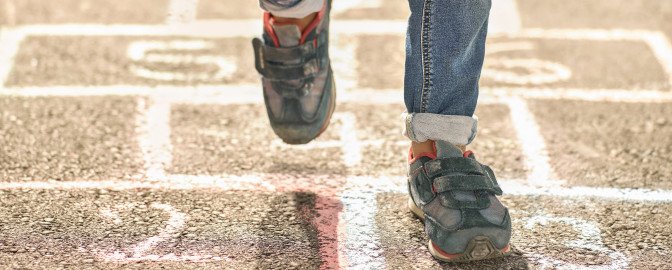
The Paediatric Orthopaedics team has over 100 years of combined experience in paediatric orthopaedics. With more than 12,000 consultations, each Paediatric Orthopaedics staff member consulted with an average of more than 1,700 children and adolescents and their parents in 2021. This high level of expertise guarantees the very best levels of care. In this way, we can also avoid unnecessary examinations and operations that are stressful for the child. This is clearly reflected in the ratio of 12,024 consultations to 583 surgeries in 2021.
“HELPING one child may not change the world, but it can change the world for that one child.”
Dr. Hannes Manner, Co-Head of Paediatric and Adolescent Orthopaedics
Close collaboration with other orthopaedic disciplines is becoming increasingly important. Specialisation has become so highly focused that a paediatric orthopaedist can no longer provide quality care in all areas. Embedded in Schulthess Klinik, which has highly specialised experts in all areas, Paediatric Orthopaedics can offer each child the optimal treatment. This primarily involves complex knee, hip and spine surgeries.
Help for children from war and crisis zones
In 2020, the Wilhelm Schulthess Foundation was able to conclude a cooperation agreement with the aid organisation Friedensdorf International. With the help of donations, this enables us to treat children from the poorest countries, who are unable to receive the treatment they need at home, free of charge at Schulthess Klinik. The children are examined by medical personnel in their home country and brought to Germany for individual case assistance. From there, they are taken to specialist clinics that have particular expertise in this area.
Our first patient in 2021 was Farrukh, a 10-year-old boy from Uzbekistan. He had suffered from a complex deformity of the right leg since birth. Pre-surgery in Uzbekistan did not prove successful; in fact, it resulted in a very strong additional deformation of the femur as well as a pre-existing length difference of 15 cm.
In an operation lasting several hours, an Ilizarov ring fixator was attached to the outside the femur. This meant that we could correct the severe deformity during the operation, while at the same time making preparations for the subsequent lengthening of the femur. Over the next three months, it was possible to lengthen the bone by a full 8 cm. In the meantime, we were able to remove the fixator.
Farrukh’s two-week stay at our clinic was very moving. After just a few days, he was moving around independently in a wheelchair – soon almost every employee in the clinic knew him. The common interest in Farrukh’s well-being and the high level of care demonstrated the strong cohesion within the clinic and was symbolic of what moves all our employees: to be there for the benefit of our patients!
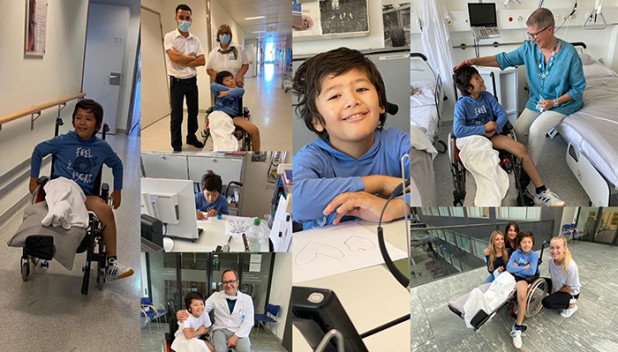
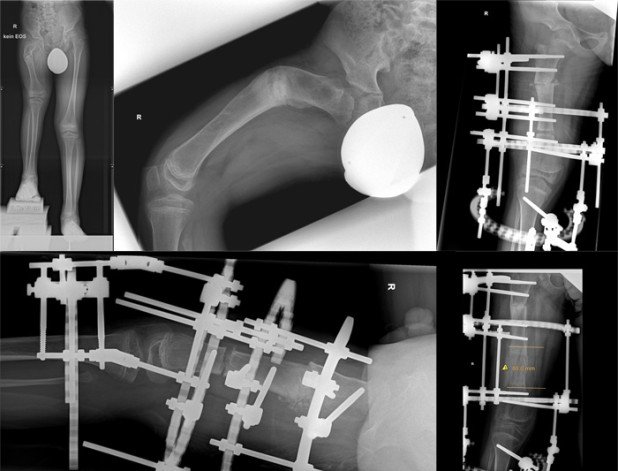
In 2022, we will host Mara, a 12-year-old girl from Angola. She has a severe deformity of the legs, which we will correct surgically thanks to the generous support from the Wilhelm Schulthess Foundation relief fund.
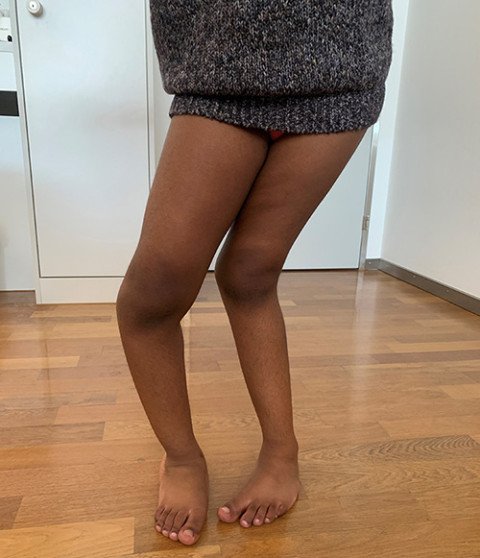
Excellent cooperation – external and internal
Our successful medical work would not be possible without the trust of our referring doctors, a highly efficient secretarial team, specialist paediatric physiotherapy, the radiology department and the entire surgical team with specialist paediatric anaesthesia, as well as the loving care on our ward and the entire hospital management and administration. On behalf of our young patients, we can’t thank them enough for this outstanding work.
Further information
Neurology
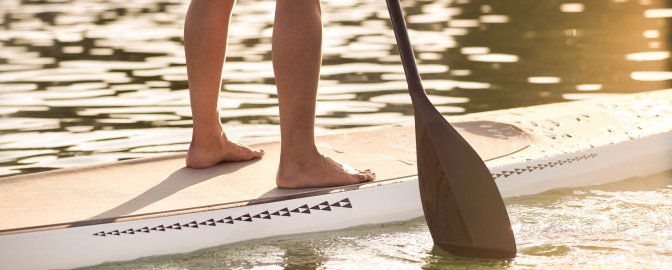
The medical team of the Neurology department consists of 10 neurologists and the newly elected Head of department Dr Christian Lanz, who has held this position since 1 January 2021. The Neurology department offers the full range of neurology diagnosis and treatment services. It now offers firmly established special consultations for multiple sclerosis, dementia, epilepsy, extrapyramidal disorders, dizziness and fatigue. These special consultations are actively used by external referring physicians and deepen the relationship of trust with the services provided by the doctors at Schulthess Klinik.
“HELPING the patient is our primary goal as well as creating an individual therapy plan adapted to their needs and symptoms. A holistic approach has top priority and takes into account the knowledge gained from working in tandem with the various specialists.”
Dr. Christian Lanz, Head of Neurology
Broad-based expertise
A large number of our doctors have additional training in manual medicine. This facilitates close interdisciplinary cooperation with our Orthopaedics and Rheumatology departments. The teams have many years of experience in these fields, meaning all doctors have excellent expertise in neuro-orthopaedic issues
as well as an in-depth knowledge of electrophysiology. In 2021 alone, we performed 4,095 electrophysiological examinations, an area in which, Schulthess Klinik – as the only non-university clinic – is a training centre for future specialists.
Unique collaboration with Spine Surgery
The spine is an extremely complex structure. Interdisciplinary cooperation between Neurology and our spinal orthopaedics colleagues is of central importance at Schulthess Klinik. Since the 1980s, we have been carrying out interdisciplinary examinations of spinal column symptoms. This means patients benefit from the knowledge of both departments and a joint evaluation. This enables us to assess the conservative and/or surgical treatment that offers the greatest chance of success in each case.
Another important element of this interdisciplinary cooperation is electrophysiological monitoring during demanding spinal operations to ensure maximum safety. The technique used in this case is multimodal intraoperative monitoring (MIOM). Unlike unimodal monitoring, MIOM combines the measurement of all motor and sensory nerve pathways. In 2021 alone, we monitored a total of 800 surgeries using MIOM.
Nerve ultrasounds as a complementary, painless diagnostic tool
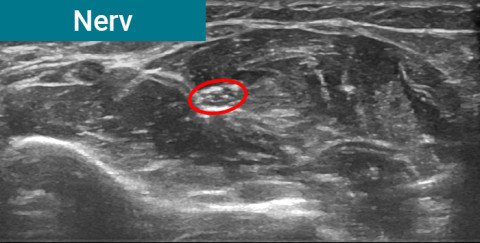
Nerve ultrasounds have become increasingly important in neurological diagnostics in recent years and have also been used by the neurologists at Schulthess Klinik for some time. They are an excellent complement to conventional electrophysiological diagnostics and are painless to perform. This method of imaging is used to map damage and pathologies in the peripheral nerves, thereby helping to find a treatment plan specific to the individual patient.
HEMMI-Stiftung foundation Research Award for Dr. Zina-Mary Manjaly
In 2021, the HEMMI-Stiftung foundation awarded its Research Award to Dr. Zina-Mary Manjaly, Schulthess Klinik’s Senior Consultant in Neurology. The nominations are designed to promote young researchers carrying out clinical research at a clinical hospital, institute or private practice in Switzerland. The foundation awards two prizes of CHF 25,000 to support the scientific work of the prize winners. Dr. Zina-Mary Manjaly received one of the two prizes for her scientific work in our Neurology department.
Further information
Anaesthesiology
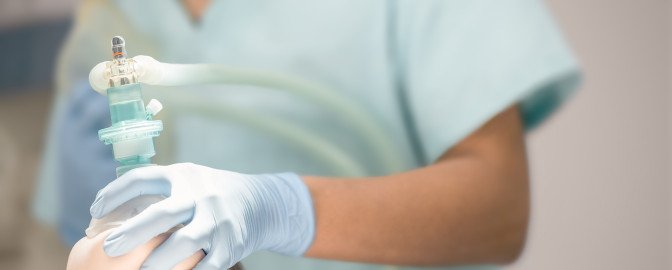
The anaesthesia team is with the patients for the entire procedure. The time spent under anaesthesia during the operation and the anaesthesia itself are just part of their work. The full scope of the patient’s care also includes consulting with them and explaining their treatment before surgery – all with the aim of achieving maximum safety and safeguarding the welfare of the patient.
“We believe RESEARCH means critically analysing our work and developing solutions so we can continually improve. The focus is on increasing patient safety even further and maintaining high levels of patient satisfaction.”
Prof. Christoph Hofer, DESA, Head of Anaesthesiology
In 2021, we were able to advance a considerable number of projects and even implement some of them, with the rest on track to come to fruition in the new year:
Preoperative assessment
The previous anaesthesia consultation format will be replaced by an interdisciplinary and interprofessional preoperative assessment. Clear structures and processes with close cooperation optimise patient safety and increase the satisfaction of our patients.
Postoperative pain management
To improve pain management, pain specialists are now available at every stage of the postoperative care of patients where needed.
Digitalisation
Anaesthesia documentation is fully digitalised, i.e. monitoring data is automatically stored and anaesthesia staff have more time for patient care.
Teaching and research
The Anaesthesia department is now offering part of the specialist training in anaesthesiology and received recognition as a category B training centre in 2021. Research is important for the department and will be further strengthened in the future. The successful postdoctoral thesis of Dr Mital Dave from 2021 is an excellent example of this.
Rheumatology and Rehabilitation

Rheumatology is a broad specialist area of medicine that addresses numerous and varied conditions ranging from degenerative joint and back conditions to inflammatory diseases (e.g. arthritis) or osteoporosis. The Rheumatology and Rehabilitation department is also a central interface for interdisciplinary diagnostics and treatment.
“We use a holistic approach to HELP our patients. When treating chronic pain, we also take into account psychological, family and work-related stress factors.”
Dr. Adrian Forster, Head of Rheumatology and Rehabilitation
Comprehensive, tailored to the individual and with the latest treatment methods
Comprehensive and individually tailored care for our patients coupled with state-of-the-art treatment methods – this is what sets our Rheumatology and Rehabilitation department apart.
We believe a holistic approach to treating chronic pain is vital. It is a matter of course for us to take psychological, family and work-related stress factors into account when doing this.
Drugs produced using biotechnology that have molecularly targeted mechanisms of action are part of our standard therapy repertoire, not only for inflammatory joint and spinal conditions, but increasingly for osteoporosis as well.
Continuous training and the advancement of technology are a must for us. For example, we are continuously developing ultrasound-guided diagnostic and therapeutic puncture techniques. The tip of even the finest needles can be guided to the anatomical target with millimetre-level precision.
Osteoporosis consultations
Patients continued to appreciate and make use of our osteoporosis consultation hours last year. In 2021, for example, we performed 703 osteological examinations, which is a further increase compared with the previous year.
An osteological assessment includes taking bone density measurements (osteodensitometry with DXA) at three sites (forearm, hip,and lumbar spine). In addition, we also calculate the trabecular bone score (TBS), which allows us to draw conclusions about the bone microstructure. If necessary, we also perform morphometry of the thoracic and lumbar spine (lateral fracture screening). All of this data and the risk factors recorded during the consultation are used to assess for risk of fracture. Using this as a basis, and taking into taking into account the patient’s needs, we develop an individual therapy proposal for each patient.
The goal is always to restore good bone stability as quickly as possible. Depending on the severity of the condition, a number of specific medications are also used in succession, or even simultaneously. In the meantime, it is almost always possible to establish an effective and tolerable therapy.
Further information
Manual Medicine
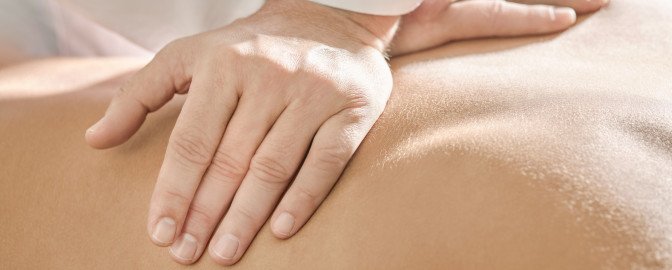
Manual medicine is mainly used to treat back problems and joint conditions. Using targeted manipulation, trigger point treatments, infiltrations guided by ultrasound and image-enhancement techniques, along with numerous other methods, this kind of treatment primarily focuses on comprehensive pain management for chronic pain. Manual medicine has a tradition at Schulthess Klinik that spans several decades.
“For us, HELPING means easing chronic pain and improving patients’ quality of life.”
Dr. Gérard Hämmerle, Head of Manual Medicine
In the context of manual and pain medicine, ‘healing’ for us means eliminating the cause of the pain as much as possible. Even in complete healing is not possible in certain situations, our department can still use helpful pain relief methods, such as with our manual techniques, various infiltrations or “transcutaneous neuromodulations”. This involves regularly supplementing existing therapy concepts so that solid findings from science and research can be expediently incorporated into the therapy we provide. An example of this are “ultrasound-guided blockades of plexuses”, which were developed only a few years ago and show a very good benefit/risk ratio, and are widely used accordingly.
Ultrasound-guided dry needling for delicate structures
If, for example, trigger points (chronic overload zones in the muscle and fascia) are the cause of pain, successful healing is often achieved with “dry needling”, a targeted treatment of the muscle using needles.
Trigger points
Muscle trigger points are persistent contractions of some/a few muscle fibres in a muscle. These often occur as a reaction to chronic overloading of muscles or as a result of a direct or indirect impact of force. A typical example of a situation where a muscle can get overloaded is an awkward posture while sitting at the computer – such as when reading an annual report... A common mechanism for the accidental development of trigger points when neck muscles are overstretched is a whiplash injury.
Depending on how severely a muscle is affected, trigger points may not cause pain but can be the cause of pain that incapacitates/immobilises the patient. Research shows that an overly acidic milieu with very low oxygen levels is found in trigger points. Without oxygen, the biochemical energy carrier ATP (adenosine triphosphate), which is needed to release the contracted muscle fibres, is also missing.
Dry needling as a treatment option
In the 1940s, doctors discovered that infiltrating local anaesthesia into trigger points could provide lasting pain relief. The researchers went on to discover that a similar effect was also observed when saline was infiltrated. When research showed that the same effect also occurred through needle insertion alone into the trigger points, i.e. without infiltration of a liquid, dry needling was born. Trigger points can therefore be relaxed by inserting needles into the muscle (dry needling). It is thought that the needle pricks stimulate the blood circulation – and thus oxygen flow – in the trigger points, whereupon the contracted muscle fibres – and thus also the trigger points – are released.
Further development of the technique – the advantages of ultrasound-guided dry needling
In traditional dry needling (where the needle is not guided using ultrasound imaging), a number of muscle groups are not treated – or only treated superficially – for safety reasons. Examples include various muscles in the neck and back which are close to the spinal cord or lungs where delicate structures could be injured. This includes the erector spinae muscles, i.e. the back muscles that lie on top of the spine.
Modern ultrasound equipment makes it possible to see not only the target muscles and the needle, but also structures that are to be avoided (lungs, blood vessels, epidural space, etc.). This increases the safety/target accuracy of the treatment and opens up the possibility of treating muscles and trigger points that could previously not be treated satisfactorily for safety reasons. Thanks to the appropriate infrastructure and the experience of our specialists, we can help many patients find the pain relief they long for.
At Schulthess Klinik, ultrasound-guided dry needling has been an established method in the department since 2019 and has been steadily developed over the last three years. We carried out numerous treatments using this technique in 2021, in particular on the erector spinae muscles.
Further information
Internal Medicine

Our Internal Medicine department uses its broad and substantial expertise to look after for all the patients before and after surgery. Incorporating such professional internal medical treatment into the clinic’s care programme enables even patients with complex underlying conditions to undergo orthopaedic surgery to improve their mobility and thus enhance their quality of life.
“For us, HEALING means taking a holistic approach to assessing the patient and considering all their concomitant illnesses to ensure they receive the best possible care.”
Dr. Margrith Knecht, Head of Internal Medicine
Orthopaedics PLUS: Specially for patients of an advanced age and/or with co-morbidities
Everyone needs to able to move in a healthy and pain-free manner, regardless of how old they are and whether they suffer from other illnesses. Depending on the situation, orthopaedic surgery can significantly improve a patient's quality of life. However, with advancing age and co-morbidities, the risks of surgery increase and so does the need for comprehensive, safe care during the patient's hospital stay.
Coordinated care involving our specialists in Orthopaedics and Internal Medicine has been a long-standing tradition at Schulthess Klinik. The “Orthopaedics PLUS” ward was launched in 2021 specifically for patients of an advanced age and/or with co-morbidities and has now been developed and its resources pooled even further. In this setting, our specialists can work hand in hand to provide interdisciplinary care to patients. This includes orthopaedics and internal medicine staff doing joint ward rounds, following clearly defined processes and having specially trained nurses and physiotherapists on hand to provide complete, tailored patient care.
The pandemic as an ever-present challenge
In 2021, the pandemic again challenged our internal medicine with numerous additional tasks and shaped the everyday workings of the clinic. The protection of patients and colleagues has always been of paramount importance.
This meant being there for medical questions about Covid-19 and supporting the Directorate’s pandemic team. In-house processes had to be quickly adapted again and again and the requirements of the Federal Office of Public Health and the Zurich Health Directorate had to be implemented. The repeated Covid pooling tests among staff, the joint vaccination campaign with other Lengg clinics and the in-house booster vaccination campaign – to name a few – were additional services that our internal medicine took on and made a major contribution to combating the pandemic.
Further information
Medico-Legal Affairs

Complex medico-legal reports require pooled expertise, which Schulthess Klinik provides. We offer this service in particular for accident, court and liability reports.
“We bring clarity to complex appraisal issues and curtail how long cases remain uncertain for. By doing this, we HELP all the parties involved – and in an independent, fair and competent manner with a comprehensive assessment that leaves as few questions as possible unanswered.”
Dr. Georg Egli, Senior Consultant in Neurology and Head of Medico-Legal Affairs
In 2021, Schulthess Klinik was again involved in various complex medico-legal reports. The expert opinions required centred around orthopaedics, neurology, rheumatology and rehabilitation, and psychiatry.
We are often asked to prepare a decisive expert opinion, i.e. when preliminary expert opinions are available that did not fully clarify the facts of the case and the medical situation. We then try to bring the process, which, in most cases, has been ongoing for a long time, to a conclusion with a comprehensive assessment. This should not leave any technical questions unanswered, so that further legal disputes lasting many years can be avoided as far as possible.
Specialised and interdisciplinary
Complex medical reports usually require both a high degree of specialisation and interdisciplinary cooperation – cooperative work that is part of everyday life at Schulthess Klinik. Depending on the issue, various specialists can be involved, all of whom are active in everyday clinical practice, have a great deal of experience and are up to date with the latest medical knowledge.
The Medico-Legal Affairs department calls upon and pools all of this expertise as needed, before putting it at the service of the client.
Further information
Sports Medicine
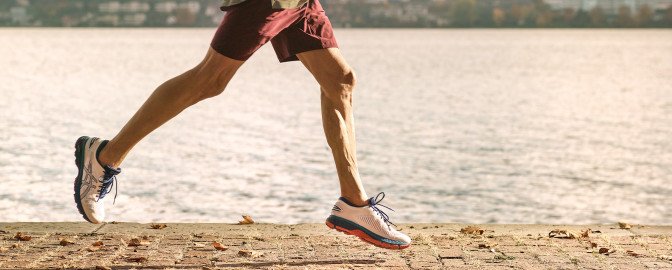
Our sports medicine team treats patients and athletes at all levels of sport. We look after professionals, amateurs and young talent in our Swiss Olympic Medical Centre at Schulthess Klinik or on the sidelines. For the second time, the past year was significantly affected by the pandemic.
“HELPING sport survive and doing our best to help fight the pandemic – that was our main focus in 2021.”
Dr. Gery Büsser, Head of Sports Medicine and Head of the Swiss Olympic Medical Centre
2021, like the previous year, was significantly affected by the pandemic, which played a part in our daily work, as well as that of the athletes and clubs in our care. This meant that, in 2021, the focus was not only on the athlete and their symptoms and inability to participate in sport, but also on the survival of sport – especially competitive sport – itself.
Covid tests, health and safety plans and vaccinations
Covid testing in teams and associations had a significant impact on our consultations and club visits. For example, in 2021 our sports medicine team carried out innumerable antigen and PCR tests as well as outbreak and ongoing routine tests both at the clinic and at our partners’ locations. A lot depended on the results and the resulting quarantine measures for the athletes as well as for the teams, clubs and associations behind them.
Furthermore, we were able to develop sophisticated health and safety plans for top-level and professional sports and constantly adapt them in close and fruitful cooperation with the relevant cantonal and national authorities. Our knowledge and experience of the conventions and procedures in the various sports proved to be fundamental for us to be able to develop any effective health and safety plans at all – and in such a way that they could be implemented in the long term.
This applied to competitions, but also to regular training. An athlete testing positive for Covid would affect the whole team or an entire event. This meant it was important to avoid people falling ill and quarantines as much as possible. A constant challenge and question we bore in mind each and every day was: “what can we do to minimise the risk of infection while still guaranteeing that the athletes can perform at their usual level?”
In collaboration with ETH and resourceful start-ups, valuable tools and interventions were created that were ideal for use in sport and beyond. We are very grateful to the many colleagues from various disciplines in our medical network for their readiness to help – we experienced an incomparable spirit of solidarity, which we definitely want to continue to foster.
We are proud that our mobile Covid test centre was not only used in sports but also at other facilities, in homes and at cultural events during the pandemic and that we were able to help out and play our part in managing the pandemic. This satisfaction also compensates for and puts into perspective the sporting moments that were lost and emotions during this time.
We also organised and carried out the Covid-19 vaccinations quickly and in an uncomplicated manner during consultation hours or at special vaccination events in connection with sport, where we benefited from excellent cooperation with the authorities.
Return to play after Covid-19
The evidence of an increased risk of myocarditis, especially after viral Covid-19 infection, and the unanswered question regarding problems associated with long Covid have led to the development of a “return to play” protocol in competitive and elite sport. The aim is to filter out dangerous sequelae after a Covid-19 infection at an early stage with simple, targeted information in a stage-adapted structured scheme.
All our athletes who test positive go through this programme, which is carried out following the illness and lasts for at least five days until they are fully fit to go back to playing their sport. Together with the athlete-exempt isolation period, this means that, while the athlete does lose a few training days, they never run the risk of a reckless and dangerous complication. Conspicuous or unclear findings are quickly and competently filtered out in our interdisciplinary expert board in order to be able to prescribe a suitable recommendation or therapy to the athlete.
The beach volleyball tournament in Gstaad: an important step for Swiss competitive sport
After being cancelled due to Covid-19 last year, the international beach volleyball tournament Gstaad Major took place once again in July 2021. As the medical partner of the tournament, our first contribution was to provide the medical team, which consisted of physiotherapists, masseurs, first-aiders and half of our sports medicine staff.
Our other significant contribution, together with the authorities, the association and the tournament management, was to develop the elaborate and strict health and safety plan for this first noteworthy major event of its kind with compulsory certification to take place during the pandemic. A task that carried all the more responsibility given that the entire world elite was at the starting line and the Olympic Games, another sporting highlight, were due to start just two weeks later in Tokyo. Thanks to the joint efforts of all parties involved and the incredible Gstaad, which steadfastly resisted the dangers of the pandemic like a fortress, Covid infections were avoided and the athletes’ path to the Olympics secured.
The past year was full of challenges, but overall we have been very impressed with how Swiss sport has fought back against Covid and shown immense solidarity and camaraderie in doing so, creating connections and friendships that extend beyond sport. Now we are ready for sport.
Further information
Therapy and Training
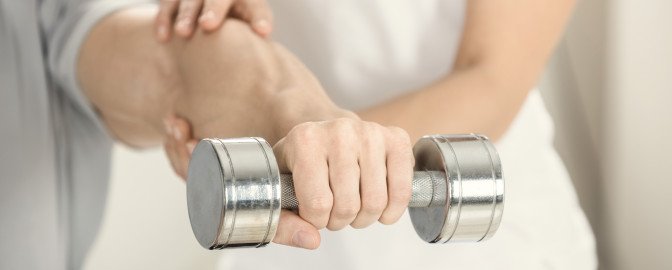
The therapy and training team looks after patients and recreational and competitive athletes who need to maintain healthy movement. This includes treatment in the event of an illness or accident affecting the musculoskeletal system, rehabilitation after operations, sports assessments, training at all sporting levels and injury prevention.
“Thanks to the excellent level of RESEARCH, we can offer physiotherapy at the highest level. We incorporate research results into our everyday work, so we are always up to date with the latest developments in the field and thus achieve better and more efficient results for patients.”
Roger Wendelspiess, Head of Therapy & Training
Our therapists are all specialised. Our physiotherapists focus on the specialist areas of the hip, knee & foot, shoulder & elbow, spine and sports physiotherapy, while our ergotherapists specialise in treating the hands. Sports therapists accompany clients and patients in their training or in medical training therapy. Our performance diagnosticians carry out sports assessments.
In 2021, in addition to everyday tasks, our team once again pushed ahead with many projects that directly promote the well-being of our patients. In addition, there were only a few – but no less exciting – sporting events on the programme in the pandemic year.
“Schulthess Coach” – the digital therapy companion
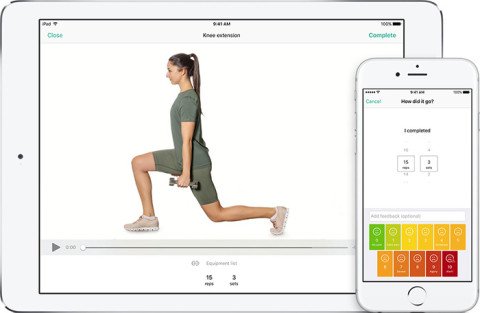
With the “Schulthess Coach” app, Schulthess Klinik has rolled out its digital therapy companion to complement the work of the entire Therapy and Training department. It is used in sports therapy, ergotherapy and physiotherapy and, as a free app, supports the (remote) care of patients with individual training and physiotherapy programmes. It allows patients receiving care via Schulthess Coach to view the specific instructions for their home exercises in the form of photos and videos, whenever and wherever they want. This means that, even at home, patients can benefit from the extensive experience of our therapists, sound scientific knowledge and a programme that is individually tailored to them. Compared with 2020 (1,284 programmes), we assigned 1,998 therapy programmes in 2021, which is around 50% more than in the previous year.
GLA:D® – living well with osteoarthritis
GLA:D® is a standardised, scientifically proven physiotherapy programme. Originally a Danish concept, it is aimed at patients suffering from knee and/or hip osteoarthritis or back pain. GLA:D® Switzerland has been around since 2019. The goals of the programme include pain reduction and improved function in everyday activities and quality of life, regardless of the extent of the osteoarthritis. It consists of a combination of individual sessions, group sessions with information and advice, and group training.
Schulthess Klinik launched GLA:D® in 2020 and aimed the course programme at knee and hip patients in 2021. In parallel, we also worked on launching GLA:D® Back, which we rolled out in 2022.
Rapid Recovery expanded
We began using Rapid Recovery as early as 2019 for patients who have received an artificial hip or knee joint. The treatment approach is designed to get the patient back into normal, everyday life and activities soon after an operation. An important aspect of it is to get patients moving around on the day of their operation. In 2021, we expanded the programme to include back, cruciate ligament and meniscus patients.
Online training for physiotherapists
Over 200 participants attended our online training programme for physiotherapists. On the topic of “Hips: best practice in physiotherapy and surgery”, our specialists from physiotherapy and hip surgery shared some fascinating knowledge and insights. The focus was on the clinical pictures of hip osteoarthritis and hip impingement.
Olympic Games Tokyo 2021
The Olympic Games were held in Tokyo in July and August 2021. Our sports physiotherapist Laura Breuss looked after the three Swiss beach volleyball teams on site. The two players, Joana Heidrich and Anouk Vergé-Dépré, gave a sensational performance, winning bronze.
Beach volleyball in Gstaad
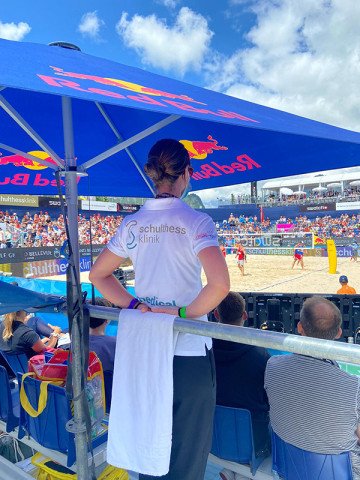
After being cancelled in 2020 due to Covid, the major beach volleyball event in Gstaad was successfully held under difficult conditions and subject to a strict health and safety plan. The major tournament was a complete success with 64 elite teams in attendance, a beautiful alpine setting and a lively crowd. As medical partner, we provided the medical team for the entire event. It consisted of 2 doctors, 4 first-aiders, 12 physiotherapists and 2 medical masseurs.
Performance diagnostics for Swiss ice hockey referees
Despite the pandemic, we again carried out numerous performance tests complete with training advice in 2021 for both professional and amateur athletes.
Since 2021, we have also been looking after the referees of the Swiss Ice Hockey Federation (SIHF). Professional strength and endurance training is essential for referees as well, so they can deliver a top performance on the ice. Our performance diagnostics lay the foundation for optimal training planning. In this context, 30 referees underwent the following tests in our Swiss Olympic Medical Centre: resting ECG, body composition measurement, explosive leg strength jumps, trunk strength test and lactate level test on the ergometer bike.
Ergotherapy: Isoforce hand splint outrigger launches internationally

Since June 2021, the Isoforce hand splint outrigger, jointly developed by Schulthess Klinik and ETH Zurich, has been marketed internationally. It was developed as a component of a static-progressive splint to improve the range of motion of the interphalangeal joints. It also supports therapy by passively training the wearer’s range of motion. At Schulthess Klinik, the development involved Ulla Jörn Good and Dr. Daniel Herren, incorporating both ergotherapy and hand surgery.
Our ergotherapy team has been using the Isoforce hand splint outrigger to treat patients for years. As the device has been consistently met with great interest at numerous further training courses in Switzerland and abroad, we have pushed ahead with international sales. Orfit Industries has now taken over distribution and production, meaning even more patients worldwide can now benefit from the innovation.
Further information
Teaching, Research and Development
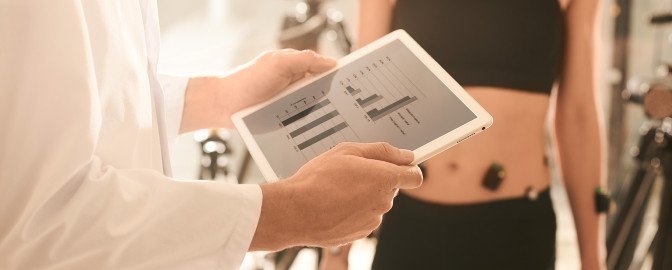
Our researchers dedicate themselves to teaching, research and development in the field of orthopaedics every day, just as Wilhelm Schulthess once did. Working in close collaboration with practising doctors, they use their research to continuously improve patient care. Our patients benefit from the resulting exchange of scientific information, which is incorporated into everyday clinical practice at our facility. We also share our knowledge with colleagues in Switzerland and abroad through our publications, teaching activities and partnerships. Our goal is to continually expand the possibilities offered by orthopaedic medicine. For this reason, research work has always been an important area of activity for the Wilhelm Schulthess Foundation, with donations being used to support a range of pioneering research projects.
“We have at all times consistently pursued RESEARCH with the goal of making patient care better and safer. This can only be achieved through the interaction of research teams, doctors, patients and the Wilhelm Schulthess Foundation with its sponsors.”
Prof. Michael Leunig, Chief Medical Officer, CMO
Prof. Markus Scheibel, Head of the Scientific Advisory Board
Julia Item, Department Head Research Management
Simone Marquart, Department Head Strategic Cooperations/Fundraising Officer
Research to continuously improve treatments
We want to know how our patients are doing. That is why we monitor them closely, even after treatment. With our long tradition of research, we have conducted more than 186,000 systematic patient surveys since 2004 and use studies to draw important conclusions for the future.
Scientific output
In the past year, our researchers and doctors have again worked together closely to produce numerous high-level scientific papers.
| 99 original papers in peer-reviewed journals | 61 peer-reviewed conference abstracs |
| 52 reviews and other articles | 201 selected lectures and courses |
| 3 books | 14 dissertations and theses |
| 45 book contributions | 8 others |
In 2021, we completed 16 research projects with one or more publications, and 128 additional projects were ongoing at year-end.
List of publications for 2021
Scientific awards in 2021
The following prestigious awards serves as to members of staff at Schulthess Klinik for their outstanding scientific achievements:
The German Society for Trauma Surgery DGU has awarded our Head of Shoulder and Elbow Surgery, Prof. Markus Scheibel the 2021 Stromeyer-Probst Medal. The award was presented in recognition of the textbook “The Shoulder – Expertise in Orthopaedics and Trauma Surgery”, which he co-published with Prof. Ulrich H. Brunner.
MINQ Magazine 2021 has named Prof. Markus Scheibel “Distinguished Specialist in Shoulder Surgery” and “Distinguished Specialist in Elbow Surgery.” Criteria include recommendations from other doctors, number of cases treated, certifications, continuing education and patient evaluations, as well as scientific publications.
The International Society of Biomechanics (ISB) has honoured Dr. Barbara Postolka’s ETH study with the ISB Clinical Biomechanics Award 2021. Schulthess Klinik was also involved in the award-winning study through our research associate, Dr.sc. ETH Renate List, as well as our Human Performance Lab.
Dr. Zina-Mary Manjaly has received the Hemmi Foundation Research Award for her scientific work in our Neurology department.
Zina-Mary Manjaly received third-party funding from the Mach-Gaensslen Foundation and the Swiss MS company totalling 114,000 Swiss francs, which will be used for studies or the employment of scientific personnel at Schulthess Klinik.
Two Schulthess Klinik abstracts were selected for presentation in the “Best Clinical Papers” session at the ISSLS (International Society for the Study of the Lumbar Spine) Annual Meeting. One of these was the dissertation of Pascal Zehnder, which was supervised by PD Dr. Anne Mannion (see below). This is a great accolade for a young doctor who is still at the beginning of his career.
Two presentations involving various Schulthess Klinik authors were selected for the “Best of Show” session at the EUROSPINE Annual Conference in Vienna in October.
For the second year in a row, the Hand Surgery and Hand Surgery Research team received the Editors’ Award of the Journal of Hand Surgery European Volume. The award was given for the study “Comparison of outcomes of three surgical approaches for proximal interphalangeal joint arthroplasty using a surface-replacing implant”.
At the 57th Annual Meeting of the Austrian Society for Trauma Surgery (ÖGU), Stefan Blümel received the award for the best abstract for his work on the treatment of pronounced flat feet using minimally invasive Achilles tendon lengthening in children. He was joined by Dr. Rafael Velasco, Head of Paediatric Orthopaedics, and the Lower Extremities Research department.
News from the research group of the Spine department
The research group of the Spine department can congratulate itself on a successful 2021 It published 30 articles in journals and presented 19 abstracts of studies at conferences.
In 2021, Schulthess Klinik entered into new collaborative partnerships with the research groups of Prof. Jeremy Fairbank at the University of Oxford, UK, and Dr. Fabio Galbusera at the IRCCS Orthopaedic Institute Galeazzi in Milan, Italy The goal was and is to further develop our forecasting models based on machine learning. The collaboration also led to us writing two international, multi-centre Horizon Europe grant proposals together. We are also very pleased to report that Dr. Galbusera has subsequently accepted a position in the Research department of Schulthess Klinik and will take up this position in 2022.
The European Spine Study Group (ESSG) is concerned with deformities of the spine in adults The Spine department of Schulthess Klinik has been involved in numerous successful research projects for many years under the direction of Dr. Frank Kleinstück as one of five participating European centres. Together with the parallel research group ISSG from the USA, we maintain the world's and develop prospective database on the treatment of such patients and conduct ongoing research projects on this basis. In 2021, we were again able to take important steps to improve the treatment of these patients.
The collaborative work undertaken by Prof. S. Ferguson and Dr. D. Ignasiak from the Department of Health Sciences and Technology (D-HEST) at ETH Zurich with PD Dr. Markus Loibl and PD Dr. Anne Mannion was continued in order to develop musculoskeletal models. The study aims to help surgeons find the ideal spinal alignment for spinal fusion procedures in order to achieve the best patient outcome.
In collaboration with Prof. Adam Pearson and Prof. Jon Lurie from Dartmouth-Hitchcock Medical Center, USA, PD Dr. Anne Mannion was able to complete a research project funded by the North American Spine Society (NASS). This study investigated whether baseline radiologic findings could influence the choice of surgical technique for degenerative spondylolisthesis. The collected data has been analysed and the scientific article is currently being written.
Two students of the Medical Faculty of the University of Zurich (Erik Holzer and Pascal Zehnder) have successfully completed their dissertations supervised by PD Dr. Anne Mannion. Their work was published in a high-quality, peer-reviewed spine journal.
Dr. Tamás Fekete successfully defended his PhD thesis on "Surgical management of degenerative disorders of the lumbar spine, with a focus on patients' perceptions" at the Szentágothai Doctoral School of Neurosciences at Semmelweis University in Budapest, Hungary. He received his dissertation summa cum laude.
The Swiss Spinal Implant Registry (SIRIS) was launched nationwide in 2021. With the valued support of Schulthess Klinik ICT department, the Spine department was able to successfully submit the required cases (>220) to the implant registry. In this process, data is transferred via an interface from our local spine surgery registry to the host of the SIRIS registry.
News from the Human Performance Lab (HPL)
In collaboration with the Sports Therapy department and the Hip Surgery medical team, the Human Performance Lab (HPL) is conducting a large-scale intervention study titled “Effectiveness of Conservative Treatment of Hip Impingement Syndrome”. By the end of 2021, 52 of 100 patients had already been enrolled in the study and are completing the active training programme portion of the trial.
Last year, the HPL team supervised a record 17 master's students from ETH Zurich and ZHAW as they completed their master's theses or internships. In addition, Dr. Romana Franceschini-Brunner received her doctorate in “Injury Prevention in Ice Hockey” with flying colours in July 2021. Katrin Dätwyler began her doctoral research, which will see her studying motion data from patients with hip impingement in collaboration with Prof. Stephen Ferguson (Institute of Biomechanics ETH Zurich).
The HPL team organised several courses for students of ETH Zurich and the Bern University of Applied Sciences and conducted an internal course on “Clinical Gait Analysis” together with Dr. Inès Kramers, Senior Consultant Medical Appraisals.
In 2021, a successful scientific partnership was established with the research group of Dr. Rintje Agricola (Erasmus University Rotterdam), from which two meta-analyses were published in the prestigious journal Osteoarthritis and Cartilage. In addition, the HPL has initiated a collaborative venture with the physiotherapy and research departments of the La Tour Clinic (Geneva).
Since autumn 2021, interested researchers, clinicians and therapists at Schulthess Klinik have had the opportunity to undergo training in the independent use of the HPL infrastructure In addition, the process for objective assessments (gait and motion analyses) for clinical evaluations was improved and made more efficient.
News from the Research Department Shoulder and Elbow Surgery and Hand Surgery
A total of 981 patients were recruited and operated on as part of a nationwide study into the arthroscopic treatment of rotator cuff tears This study, led by Prof. Laurent Audigé together with the University of Basel, involves 18 clinics in Switzerland and one in Germany. We expect the first results in the coming year.
In October, the Hand Surgery Research team visited the Erasmus Medical centre and the Xpert Clinic in Rotterdam, the Netherlands. Over the course of two days, we gained insights into the research conducted by the university and the hand surgery activities of the special clinic. We are pleased to have entered into a partnership with these internationally renowned institutions with the goal of further improving hand surgery treatments through joint research.
Together with medical device manufacturer Smith & Nephew, we launched a study to evaluate the safety and efficacy of a shoulder tendon tear with or without a patch to repair the tear.
News from the Lower Extremities Research Department
In late 2021, the Lower Extremities Research Department was tasked with collecting patient questionnaires for the Swiss Implant Registry SIRIS. The team built its own new registry for this purpose within two months, began data collection on 1 January 2022, and is now responsible for data collection at the clinic.
Two students from D-HEST at ETH Zurich completed their master's thesis under the supervision of Dr. Vincent Stadelmann and in collaboration with Prof. Stephen Ferguson in 2021. Tina Sennhauser investigated the influence of bone microstructure on partial knee prostheses. David Hasler addressed the relationship between knee sound and the microstructure of tibia bone and articular cartilage. The scope of our cooperation with ETH continues to grow. Four students are already scheduled to write their master’s theses in 2022.
Meanwhile, the collaboration with Jerôme Thevenot and David Attenzia from Sensemodi at EPF Lausanne is picking up speed. The company is developing a smart, multi-parametric, wearable device to assess knee health. Our Lower Extremities Research Department is their primary clinical partner. Several projects are underway or in planning.
Knowledge gained through our research
Below are some highlights from the numerous publications of our research with treatment-relevant results.
“Patients with osteoarthritis of the joints between the first and second cervical vertebrae or destruction and dislocation of these joints due to rheumatoid arthritis usually present with chronic neck pain radiating to the back of the head and a painfully limited ability to turn the head. In patients in whom conservative treatment is unsuccessful, vertebral fusion is usually suggested. It is considered a complicated procedure. Our large group of patients undergoing this procedure showed very good results, even exceeding the results of simpler procedures. This demonstrates that this procedure is safe when performed by experienced surgeons at a major spine centre in appropriately indicated patients.”
Kleinstuck, F. S., Fekete, T. F., Loibl, M., Jeszenszky, D., Haschtmann, D., Porchet, F. and Mannion, A. F. (2021). Patient-rated outcome after atlantoaxial (C1-C2) fusion: more than a decade of evaluation of 2-year outcomes in 126 patients. Eur Spine J, 30(12): 3620-3630. https://doi.org/10.1007/s00586-021-06959-1
“Based on data from nearly 24,000 patients registered in the EUROSPINE spine surgery registry, we developed two models. These models could be used to predict the likelihood of occurrence of a complication associated with spine surgery. Repeat surgery at the same level of the spine increased the risk of surgical complications. Having a large number of secondary conditions also led to a higher risk of general complications. Furthermore, a web-based prediction tool was also developed to help surgeons predict individual patient risk based on 10 simple input variables. https://sst.schulthess-app.ch/»
Zehnder, P., Held, U., Pigott, T., Luca, A., Loibl, M., Reitmeir, R., Fekete, T., Haschtmann, D. and Mannion, A. F. (2021). Development of a model to predict the probability of incurring a complication during spine surgery. Eur Spine J. 30(5): 1337-1354. https://doi.org/10.1007/s00586-021-06777-5
“In one study, we used a statistical method (meta-analysis) to show that certain hip morphologies, such as an altered femoral head and dysplasia, are risk factors for the development of hip osteoarthritis. For this purpose, 30 primary studies with a total of more than 25,000 patients were statistically analysed.”
Casartelli, N. C., Maffiuletti, N. A., Valenzuela, P. L., Grassi, A., Ferrari, E., van Buuren, M. M. A., Nevitt, M. C., Leunig, M. and Agricola, R. (2021). Is hip morphology a risk factor for developing hip osteoarthritis? A systematic review with meta-analysis. Osteoarthritis Cartilage 29: 1252-1264. https://doi.org/10.1016/j.joca.2021.06.007
“The combination of low-dose imaging, gait analysis and computer-based modelling allows us to calculate the load within the hip joint at different femoral torsion angles (rotation of the femur). In the future, this technique could be used to identify patients at increased risk for cartilage damage or early development of hip osteoarthritis based on their femoral torsion angle.”
De Pieri, E., Friesenbichler, B., List, R., Monn, S., Casartelli, N. C., Leunig, M. and Ferguson, S. J. (2021). Subject-specific modeling of femoral torsion influences the prediction of hip loading during gait in asymptomatic adults. Front Bioeng Biotechnol 9: 679360. https://doi.org/10.3389/fbioe.2021.679360
«Eating fondue is back on the menu: In the case of painful arthrosis of the thumb end joint, this joint is usually surgically stiffened. Our hand surgeons have now placed an artificial joint in selected patients. This allows the thumb to retain some mobility, which is important when gripping or turning a fondue fork, for example.”
Schindele, S., Marks, M. and Herren, D. B. (2021). Thumb interphalangeal joint arthroplasty with a surface replacing implant: two-year results. J Hand Surg Am. doi: 10.1016/j.jhsa.2021.09.007. Epub ahead of print. https://doi.org/10.1016/j.jhsa.2021.09.007
«Sports do not harm the inverse shoulder prosthesis: We investigated the question of whether sports in which the shoulder is active are detrimental to an inverse shoulder prosthesis. However, five years after surgery, the shoulder of the athletically active patients was doing just as well as the patients who did not partake in any sports. X-rays also showed no adverse effects of athletic stress on the prosthesis.”
Endell, D., Audigé, L., Grob, A., Schwyzer, H.-K., Glanzmann, M., Marzel, A. and Scheibel, M. (2021). Impact of sports activity on medium-term clinical and radiological outcome after reverse shoulder arthroplasty in cuff deficient arthropathy; an institutional register-based analysis. J Clin Med 10(4):828. https://doi.org/10.3390/jcm10040828
“Non-standard positioning of the hip on the X-ray, for example due to excessive external rotation of the legs, can lead to incorrect calculation of the femoral head centre of rotation during subsequent prosthesis planning. However, correct positioning of this is very important for good function of the new hip. We identified two bone contours – the trochanteric crest and the piriform fossa – and tested the extent to which their distance from each other could be used as a feature to determine unsuitable radiographs.”
Blümel, S., Stadelmann, V. A., Brioschi, M., Küffer, A., Leunig, M. and Rüdiger, H.A. (2021). The trochanteric double contour is a valuable landmark for assessing femoral offset underestimation on standard radiographs: a retrospective study. BMC Musculoskeletal Disorders, 22(1):310. https://doi.org/10.1186/s12891-021-04133-8
Further information
Inpatient Departments Nursing Services
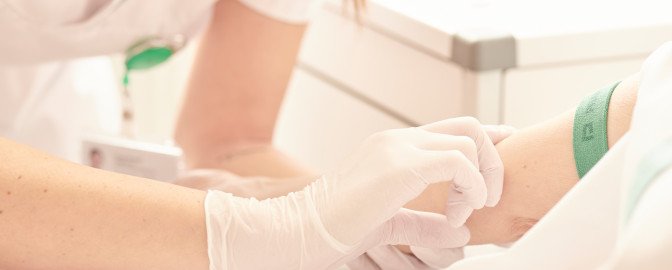
Caring for our patients in a tailored, professional, interdisciplinary and future-oriented manner is not only at the heart of our nursing mission statement, but is also practised every day by our 196 employees in five inpatient departments. Together, these make up 133 full-time positions and comprise five professional groups.
“In nursing, HELPING means supporting and promoting interdisciplinary cooperation..”
Falko Küker, Unit Manager Nursing Services
Focus on shortage of skilled nursing staff
The coronavirus pandemic has challenged us all and demanded a lot from us, especially those who work in healthcare. The pandemic brought the shortage of staff in the health sector into focus, especially in nursing. This shortage of staff is largely due to the rapid staff turnover and the lack of young talent in the profession. Would-be healthcare professionals are now better informed than before about the high levels of stress in the care sector and are pausing to think twice about whether care is a good career choice.
At the political level, a lot is already being done to strengthen the nursing profession. It is at least as important that the hospitals themselves be committed to making the nursing profession – and thus also the working conditions and environment – attractive. We have also been working on a number of projects in the past year.
Introduction of coaching sessions
The nursing service kicked things off with a series of coaching sessions last year. The aim of these coaching sessions is to achieve a uniform understanding of the individual development and management of our employees. We want to grasp the concerns and needs of our staff and develop a common understanding of leadership that is even more employee-centric.
As a result, we want our employees to have even more say in their own development and achieve greater job satisfaction. In addition, we want to more intensively promote an approach that views each employee in a holistic way and to place this more in the context of good team composition.
This had already been implemented in principle before the coaching sessions, but has been able to be strengthened in terms of consistency and structure.
Further measures to increase employee satisfaction
Every day we see fresh examples demonstrating the flexibility and motivation of our employees in the nursing service. For them, the care of our patients comes first, and this is something we are incredibly proud of. It therefore goes without saying that we strive to implement further measures to increase our employee satisfaction. Last year, for example, we launched a pilot project in which employees plan their duty rosters themselves. We are also looking into introducing more flexible employment models. And we are continuing to check in with our employees so we can provide them with a working environment that allows them to enjoy their jobs.
In addition, we have created the job profile for a specialist in charge of the nursing service. This decision is also intended to further promote and develop the profession of nursing in the exact place where the fundamental work occurs: with the patient. With direct coaching on site, the competence, quality and satisfaction of care should continue to be increased and further developed.
Further information
OP Management
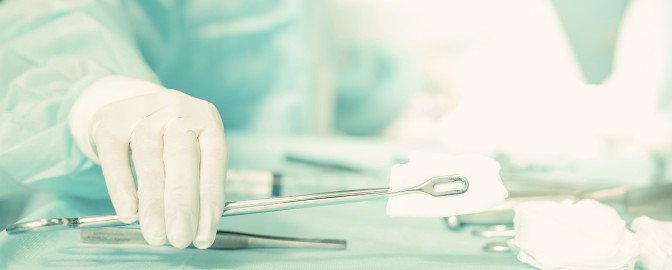
Over 9500 operations are performed each year in the state-of-the-art operating theatres at Schulthess Klinik. The well-being and safety of patients are the top priority. In addition to standardised procedures, which we review on an ongoing basis, a wide variety of professional groups work hand in hand here. In addition to doctors, these include anaesthesia nursing, surgical nursing/surgical technology, positioning specialists, operating theatre logistics, nurses, health care assistants, cleaning staff and nursing assistants.
“In such a highly specialised setting as the operating theatre, it is clear to us that we think in terms of processes and solutions, regardless of our place in the professional hierarchy. All professional groups bear in mind the big picture and are always HELPING each other – and thus also the patients.”
Patrick Gressbach, Head of OR Management
In our operating theatres, the latest technology, highly trained staff and efficient processes work together, always with the patient at the centre. In 2021, our team once again pushed ahead with many projects in these areas in addition to fulfilling their demanding day-to-day tasks.
Focus on processes and infrastructure
A good infrastructure and efficient processes that include all the professionals involved are the be-all and end-all for a motivated team and essential for a top performance in the operating theatre wing. We have also done a lot in the past year to increase effectiveness and efficiency – or, to put it another way, to do the right things at the right time of day.
Standardised anaesthesia workstations
An important aspect is the standardisation of all anaesthesia workstations by installing the same equipment everywhere, meaning employees have consistency in the equipment they use, wherever they are. This standardisation and unification of equipment represent first and foremost a further improvement in patient safety and also promote efficiency.
New operating theatre daily cockpit
The surgical area is always the most cost-intensive and highly specialised part of any hospital and requires a precise overview of the individual process steps involved. Our new operating theatre daily cockpit allows us to monitor and analyse these steps in detail and draw the necessary conclusions for adjustments based on this data. The associated report is generated on the following day, i.e. at a time when the events – both positive and negative – are still ongoing and can be included in the analysis and considerations.
Four Ss concept in the osteosynthesis of large fragments
Furthermore, a clinic-specific portfolio optimisation was carried out with the “four Ss” concept (standard, sterile, service, safety) in the field of osteosynthesis. Osteosynthesis refers to various surgical procedures used in the treatment of bone fractures. The aim of osteosynthesis is to reunite and stabilise the individual bone fragments using screws and plates so that the bone can heal.
The four Ss concept pursues three overarching goals: The aim of the project is to reduce costs, increase efficiency and ensure compliance with the legal framework in the future. The existing process regarding osteosynthesis materials was not able to fulfil these criteria for several reasons. Therefore, we needed to switch to standardised, individually packaged and pre-sterilised materials, and this is the core purpose of the four Ss project. As a result, it is now no longer necessary to compile specific sets for a doctor or a speciality in the clinic. And, as a consequence, the number of pieces that need to be stored has been reduced. The costs incurred for osteosynthesis materials have been reduced and individual equipment stores have been streamlined, which also reduces costs. At the same time, this has resulted in an increase in efficiency, as the planning process is less complex and time-consuming.
All these improvements enabled us to operate on 438 more patients within the regular working hours of 7 a.m. to 4 p.m. than in the previous year, which means an increase of 5.6% – and all with the same number of staff. The great advantage of this is that all the clinic’s supporting departments are also available at this time of day, which ultimately benefits not only efficiency, but all staff and patients.
Focus on education and training
Since 2021, we have been introducing our health professionals to anaesthesia care. This insight into another department promotes understanding across professional groups, adds another layer of interest to people’s jobs and enables further career planning.
We also celebrated the first successful graduation of a perioperative assistant in operating theatre nursing. Perioperative assistants support the qualified operating theatre staff and, in cooperation with them, care for patients during their stay in the operating theatre wing.
Robotics in the operating theatre
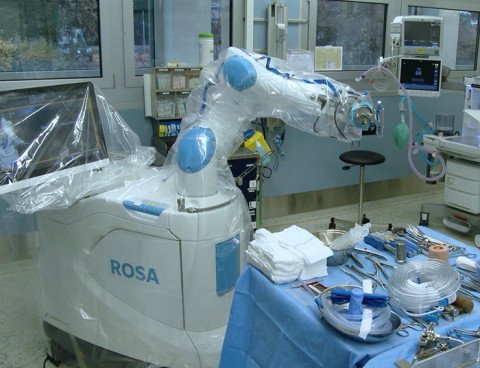
Digitalisation is also noticeably making its way into operating theatres. As an innovative clinic, we are constantly implementing the latest technologies and putting them through their paces in practice. We are also continuously gaining experience with the latest generation of orthopaedic robots. In 2021, the orthopaedic robot “ROSA” produced by the medical technology company Zimmer Biomet made a particularly frequent appearance in our operating theatre. The robot supports surgeons in performing knee prostheses operations. When implementing a robot, surgeons, operating theatre staff and technology must work hand in hand to ensure a smooth surgical procedure.
Further information
Radiology
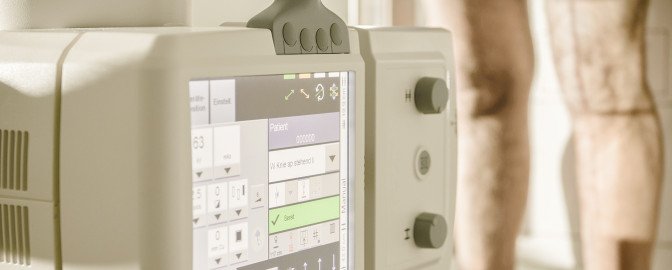
The Radiology department of Schulthess Klinik has state-of-the-art, dose-reduced X-ray equipment, with digital complete leg and spine imaging (EOS) in 2D (animated film) and 3D technology being a special feature.
“For us, HELPING means treating our patients with care and empathy so that they feel in safe hands.”
Danijela Zivkovic Jurisic, Radiology Department Manager
The interplay of state-of-the-art technology, efficient processes and highly qualified, empathetic staff underpins our department. This allows us to contribute to finding a reliable diagnosis at the highest level. As always, all of these factors were our central focus in 2021.
Short treatment and processing times
Patients should not have to spend time with us unnecessarily. This is why our goal in 2021 was to achieve a treatment and processing time of less than 30 minutes for more than 90% of patients – and we went one better, achieving this for 97% of patients.
Further training cooperation with the Medical Radiology Institute MRI
Since 2021, we have been working closely with the Medical Radiological Institute MRI, which has its own separate location at Schulthess Klinik. This gives our radiology specialists (MTRA) the opportunity to complete further training in the field of MRI.
External referrals for whole-body imaging
One of our specialities are the EOS full body scanners. These enable precise whole-body diagnostics in the field of paediatric orthopaedics, spine surgery and knee surgery. This state-of-the-art technology allows the whole body to be scanned in just a few seconds with a very low dose of radiation. It is therefore invaluable in diagnosing and planning treatment for various conditions (especially in children), such as growth-related malpositions of the extremities, leg length differences and various spinal deformities (scoliosis).
Since November 2021, we have also been accepting external referrals in this area.
New Flex room
Our new Flex X-ray room with a Philips X-ray unit has a fully motorised system including ceiling mount and swivelling table. This makes it easier for bedridden people and wheelchair users and offers them more comfort.
Further information
Hospitality
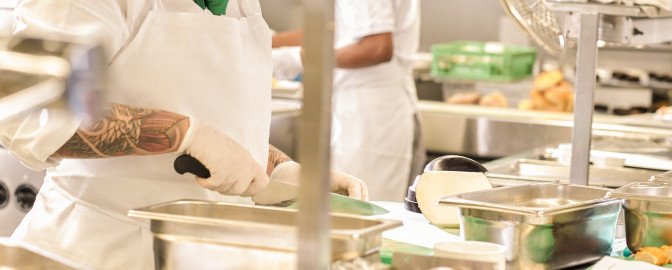
The top priority of our Hospitality Unit is to support the medical process and all our services and to make our patients’ stay with us as pleasant as possible. The some 120 employees from a wide range of professional groups work hand in hand to achieve this.
“Practising sustainability in the food sector not only conserves our resources, but also enables our patients and staff to enjoy healthy and tasty meals every day. So with sustainability in mind, we are not only HELPING the environment, but also supporting patient recovery and staff performance.”
Ramona Urwyler, Head of Hospitality Unit
A team made up of diverse professional groups
The hospitality sector includes a wide variety of professional groups who work in the background and foreground to ensure a pleasant stay for our patients, as well as catering for our staff. Cooks, assistant cooks and other staff in the kitchen, restaurant and bistro prepare and serve food and also assist with events and catering tasks. The reception and telephone switchboard handle requests of all kinds and room service pampers our patients. And without the housekeeping, cleaning, laundry and sewing staff, who often work in the background, the clinic would not be able to run.
“Schulthess Klinik goes green” is an important focus in the Hospitality Unit
Schulthess Klinik has long been committed to working in the most resource- and climate-friendly way possible. Big and small sustainability projects are continuously being implemented under the slogan “Schulthess Klinik goes green” – and a large part of that takes place in the Hospitality Unit.
Sustainability is therefore a strong focus for us, especially when it comes to our culinary services. For purchasing, this means considering regional and seasonal food and/or food certified as sustainable wherever possible, or even working with a biodynamic farm. We coordinate orders to avoid unnecessary journeys being made. Since the production of plant-based food consumes significantly fewer resources than the meat industry, our kitchen team shows how varied and delicious vegetarian cuisine can be on a daily basis. Meat-free Thursday is now a permanent part of menu planning.
In 2021, various larger and smaller projects were also implemented to promote sustainability, including in the use of ecological products, waste avoidance methods and recycling. In 2021, for example, all 22 dishwashing machines at Schulthess Klinik were switched to an ecological detergent without chlorine. In addition, all 8,000 plastic cover sheets from the patient beds, which are necessary for bed transport due to hygiene guidelines, are now recycled. Since the introduction of pre-impregnated cleaning cloths and mops, we have saved about one third of the water and detergent used in housekeeping. The cleaning agent is dosed directly onto the cleaning textile and is immediately ready for use, which also saves time. With these and many other projects, we are continuously committed to becoming more sustainable.
Two new inclusion roles
In 2021, we created two inclusion roles for employees with a disability in our Hospitality Unit. In the kitchen we are supported by a staff member with hearing and speech impairments, and in room service by a staff member with a visual impairment. We hope to continue contributing to the inclusion of people with disabilities in the future and are already in the process of developing further projects. The Profil Work & Handicap Foundation has proven to be a valuable partner in this process. “The open attitude, appreciative working atmosphere and clear communication at Schulthess Klinik are factors that contribute to the successful inclusion of staff with disabilities,” says Simon Copat, specialist advisor for work integration at Profil – Work & Handicap.
